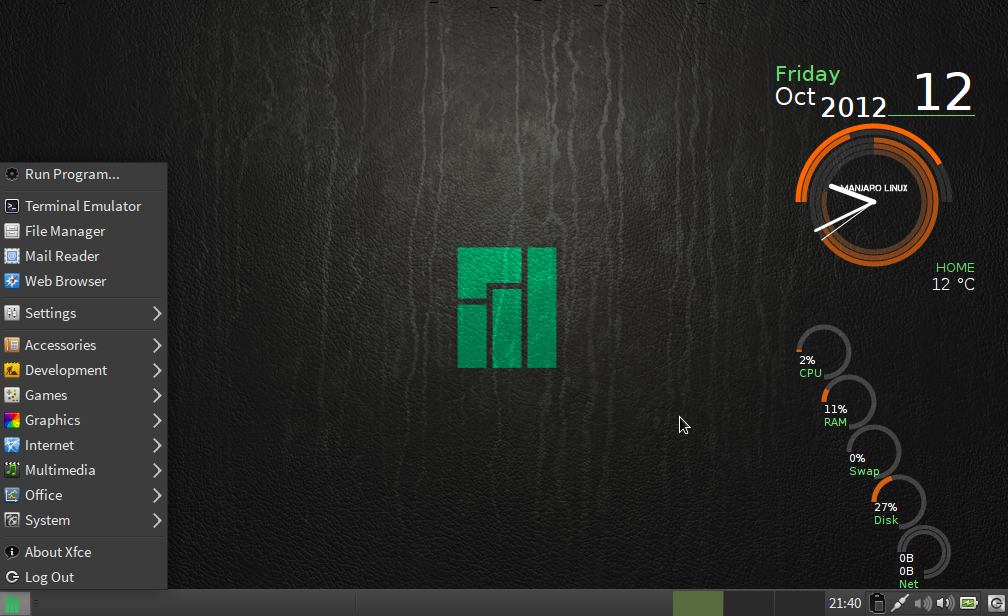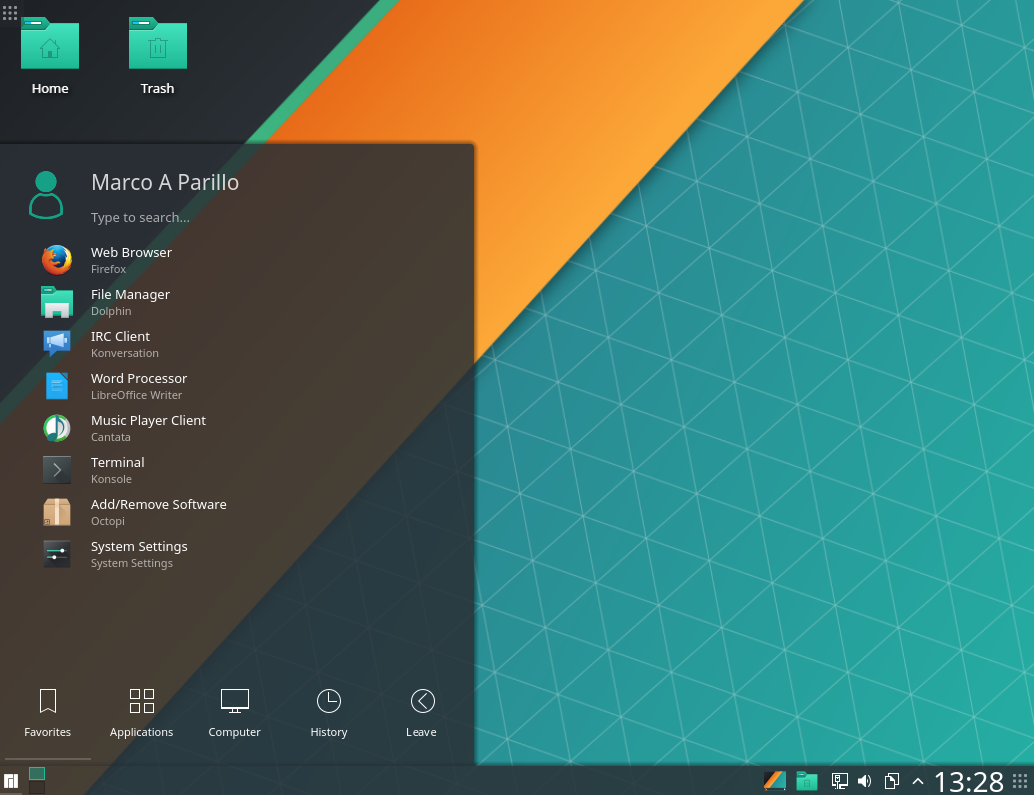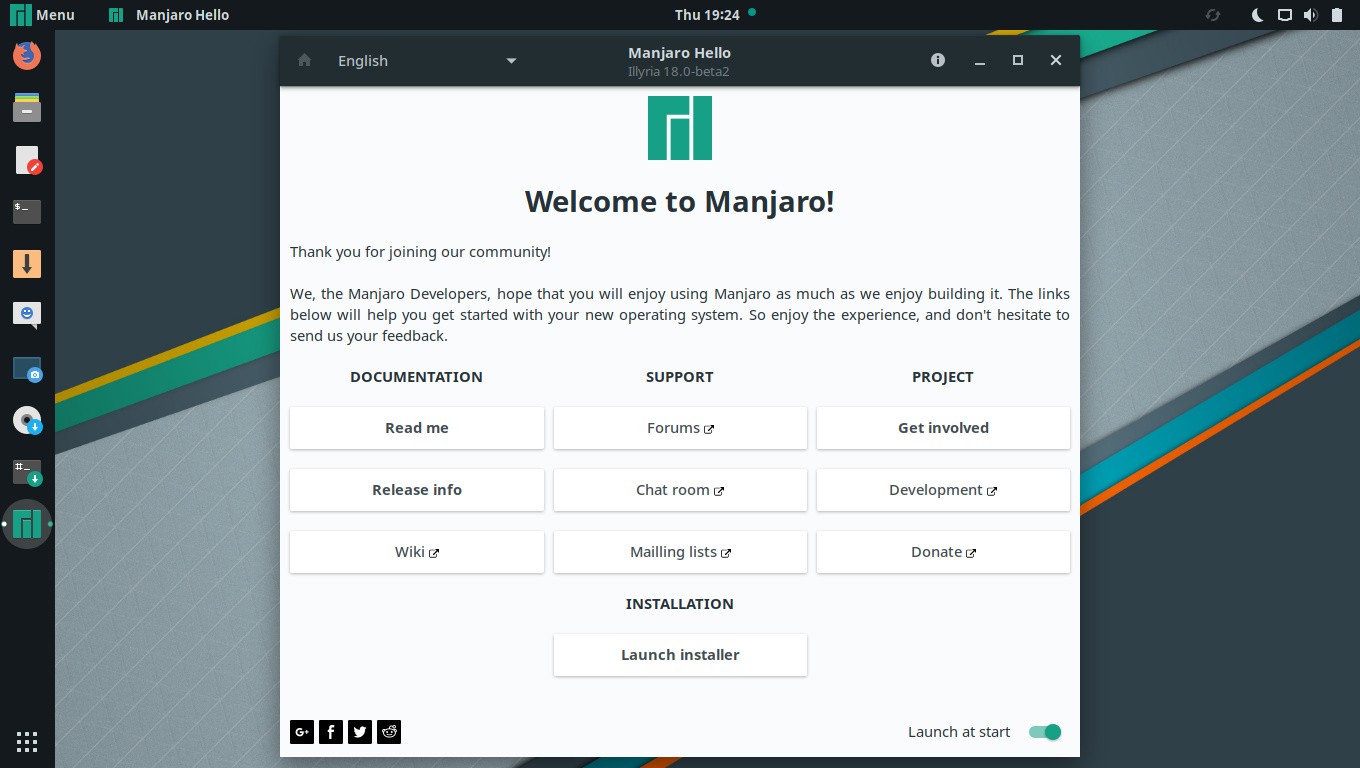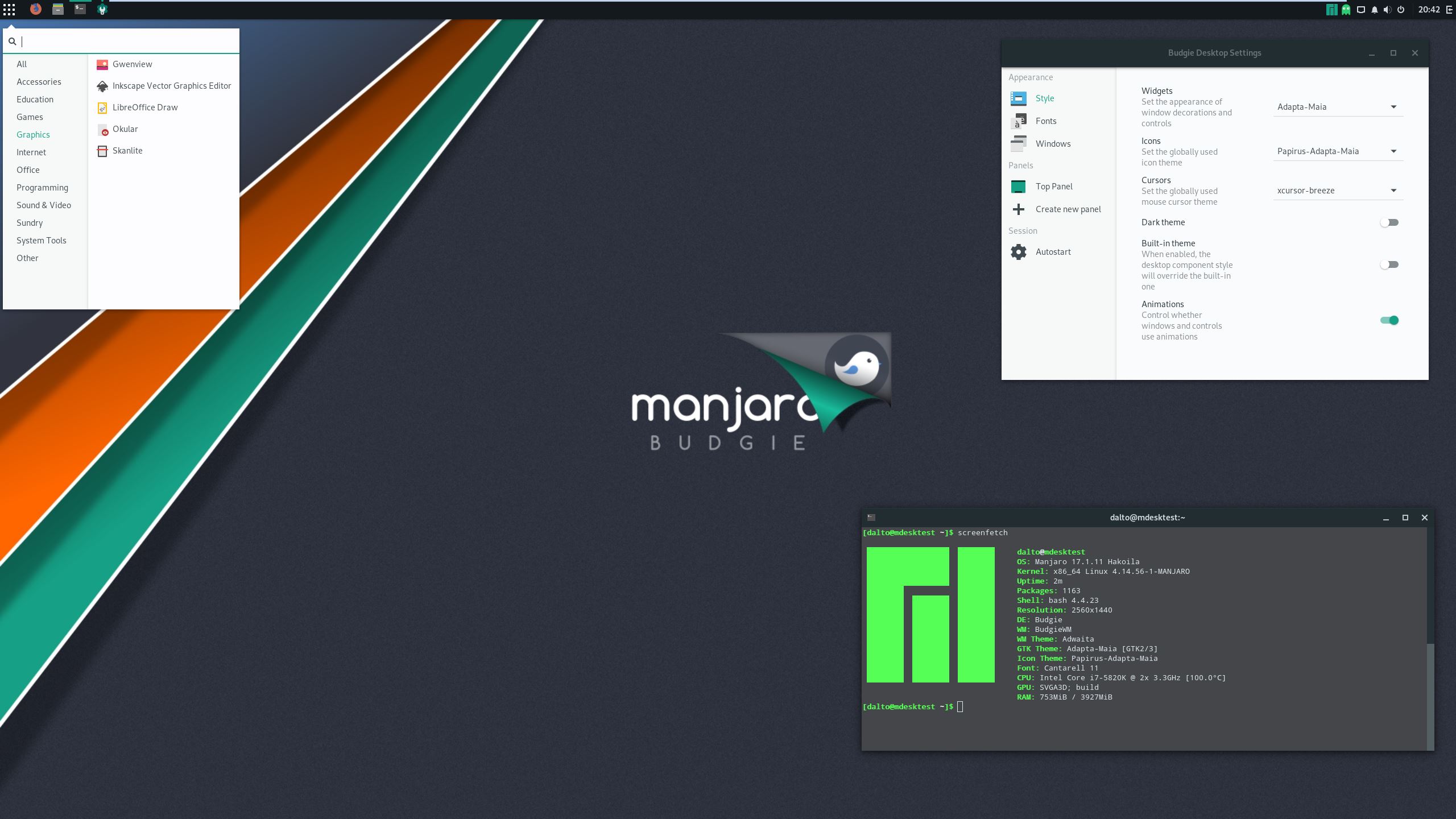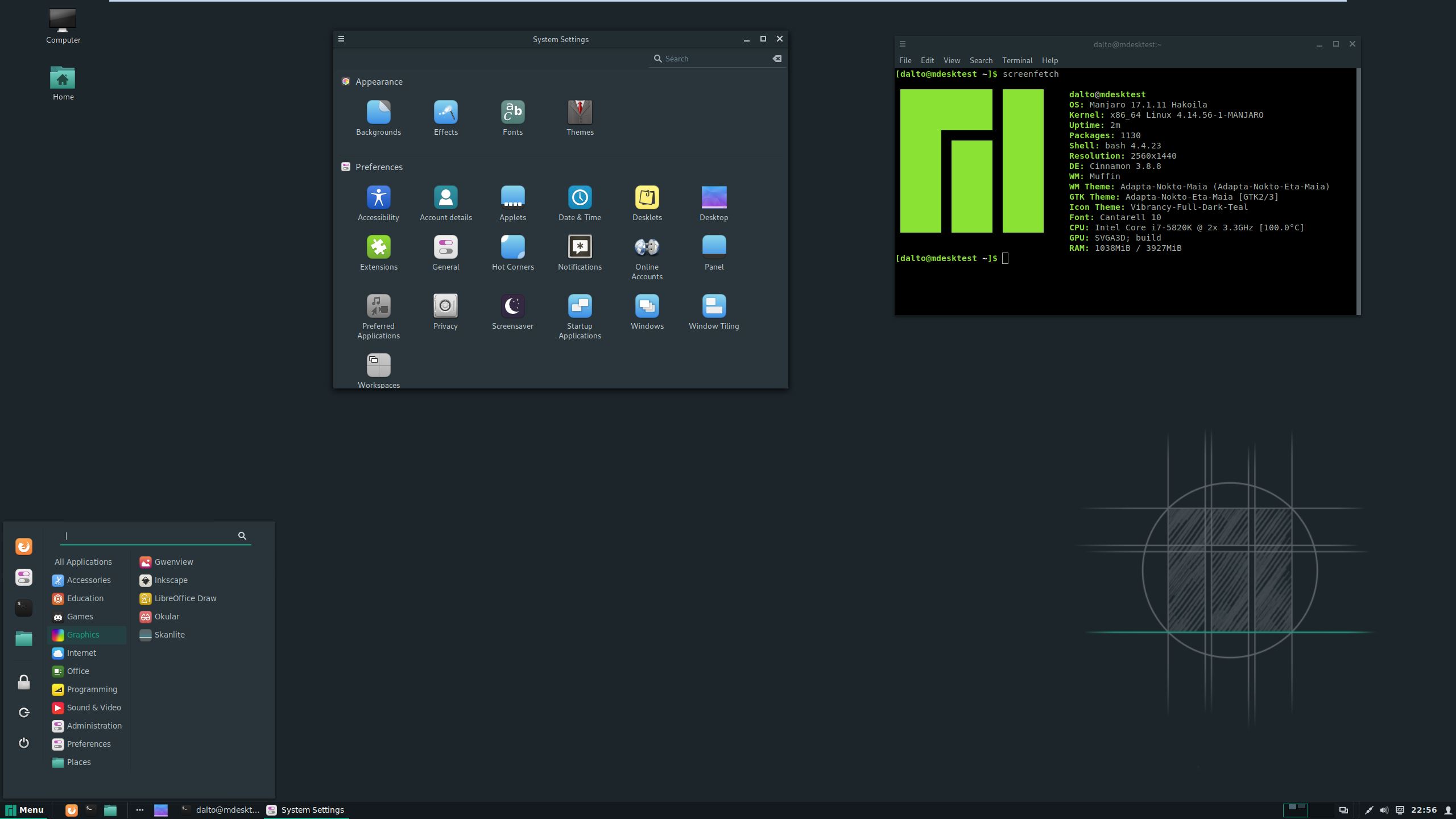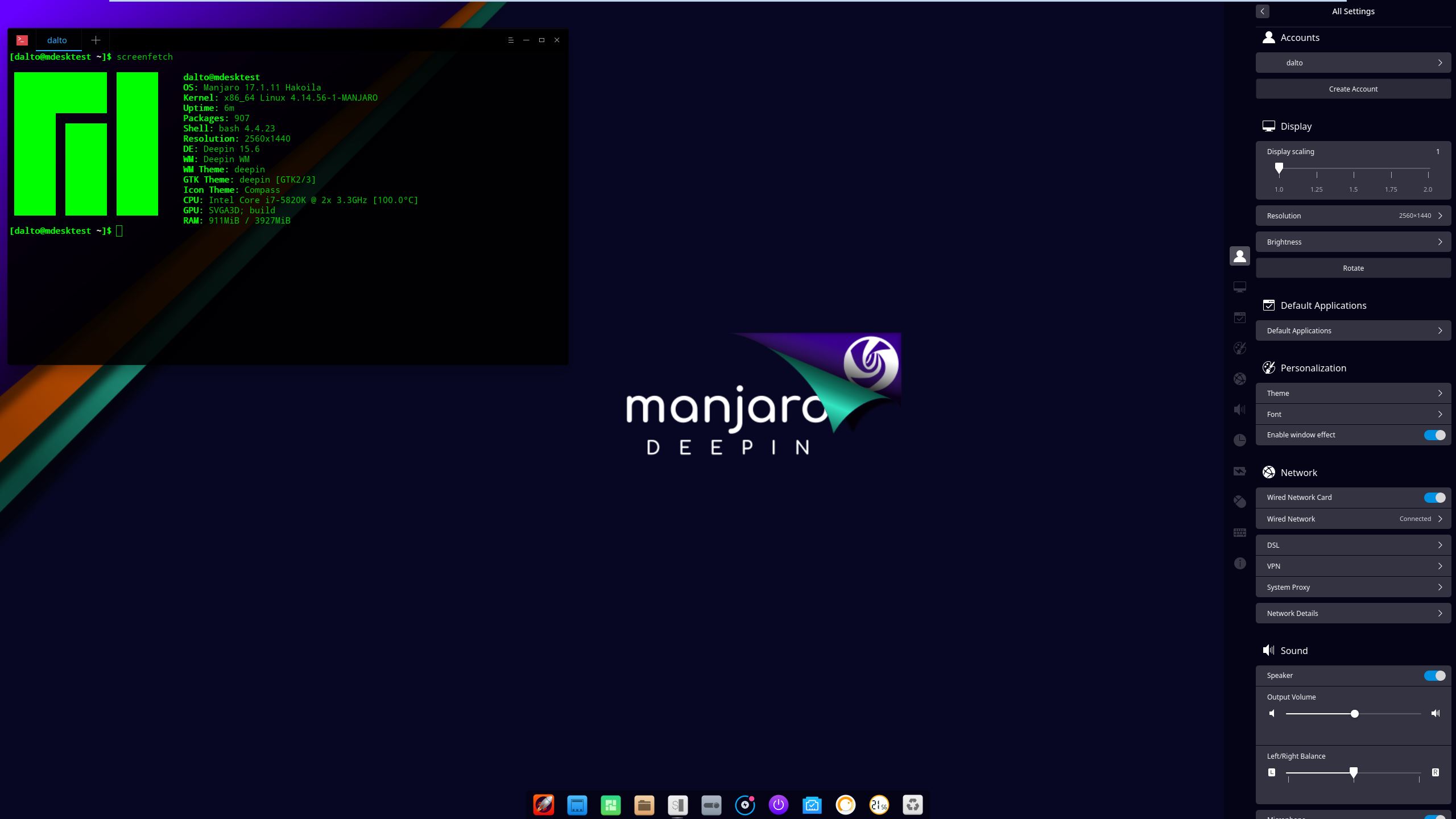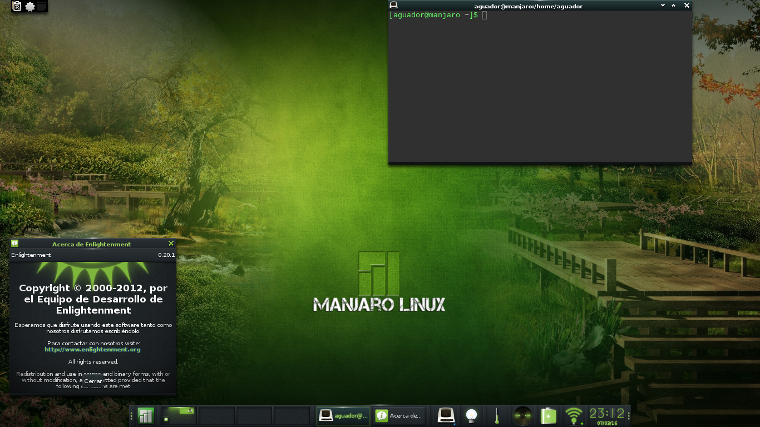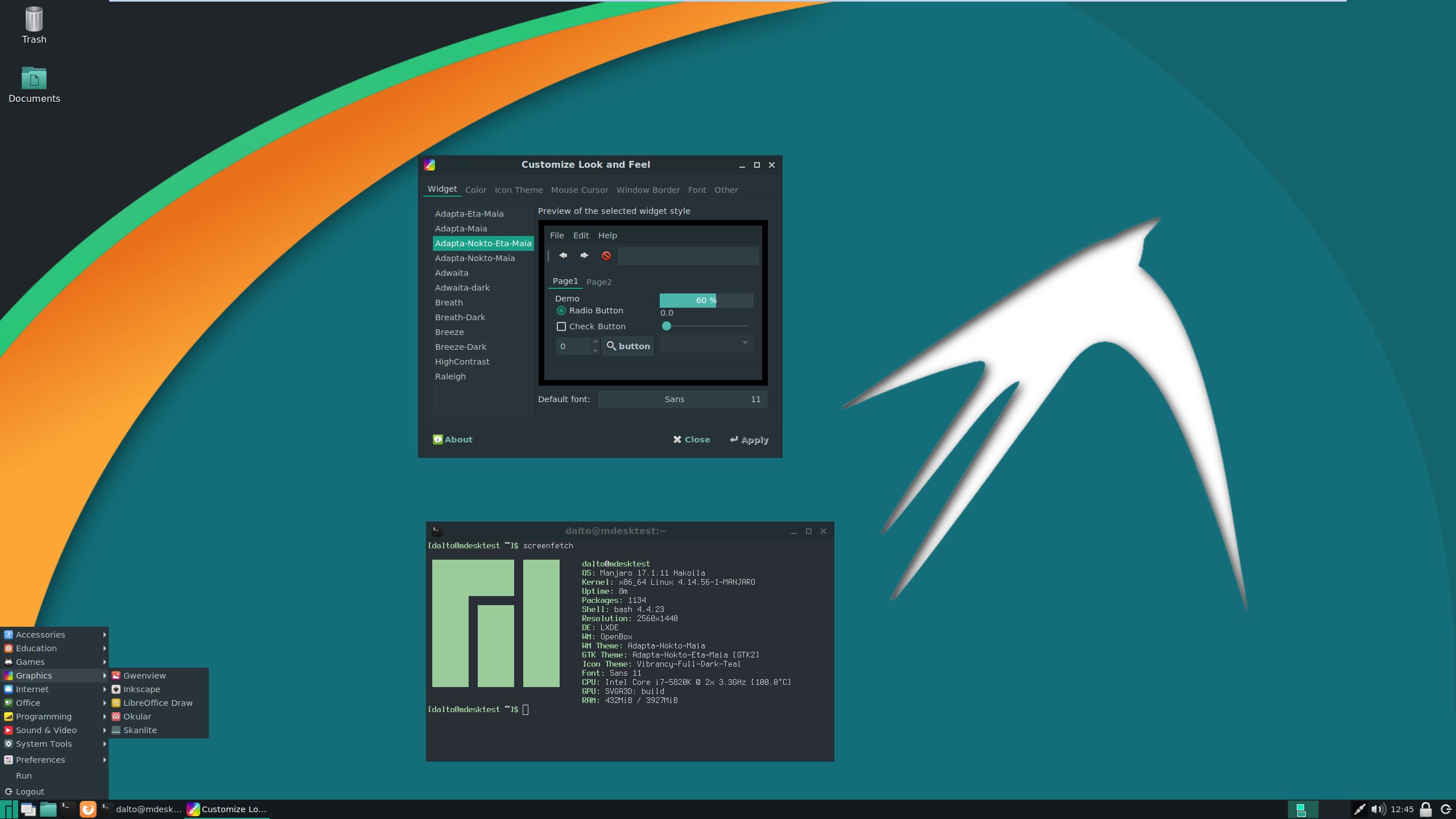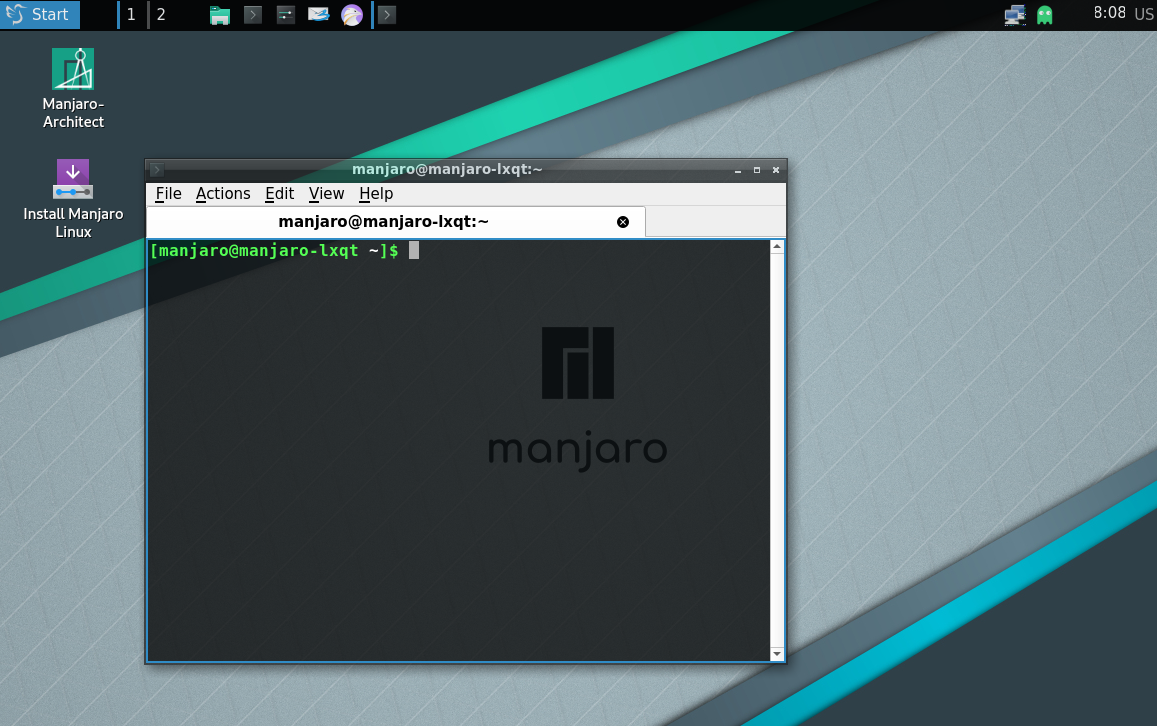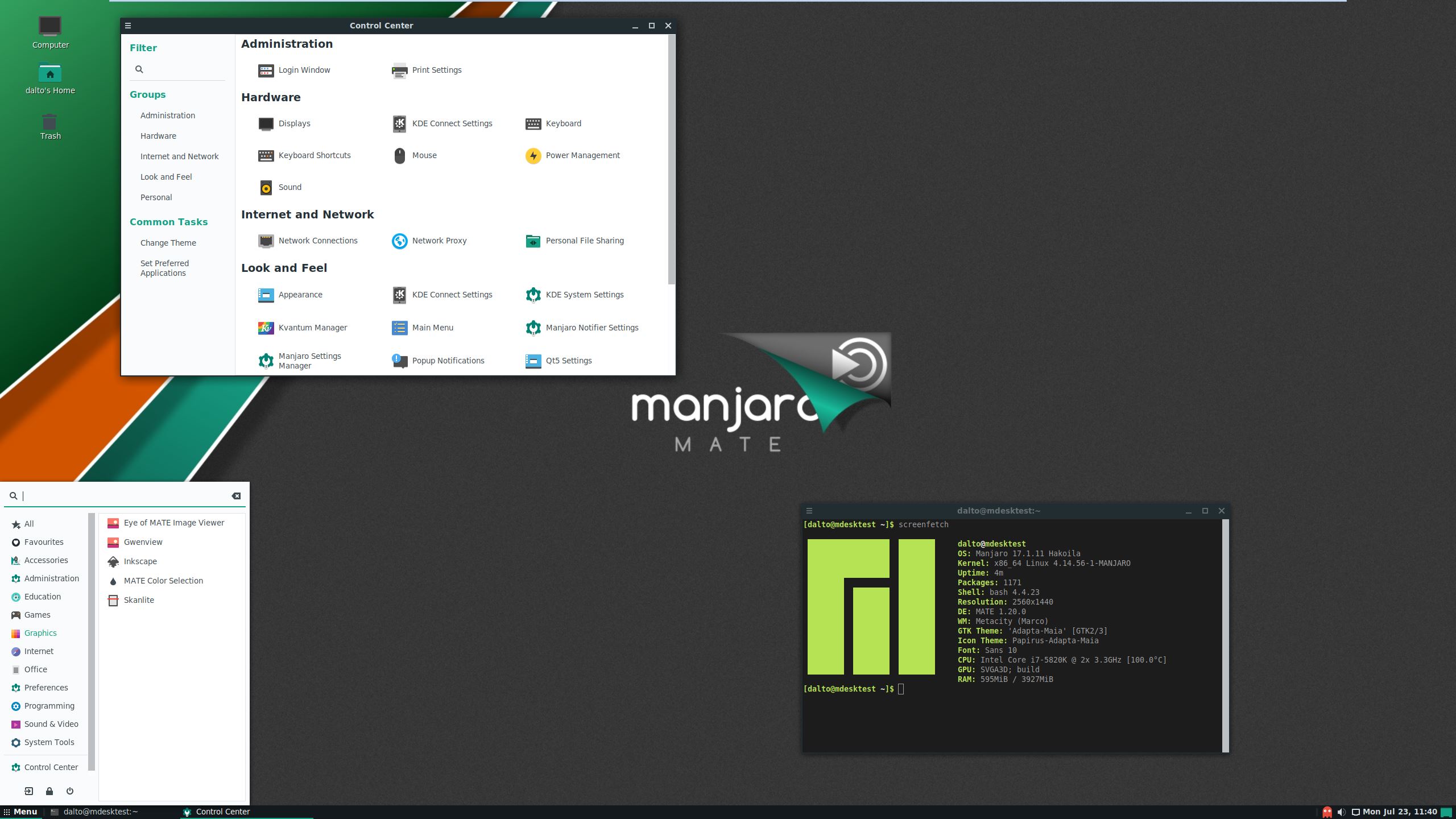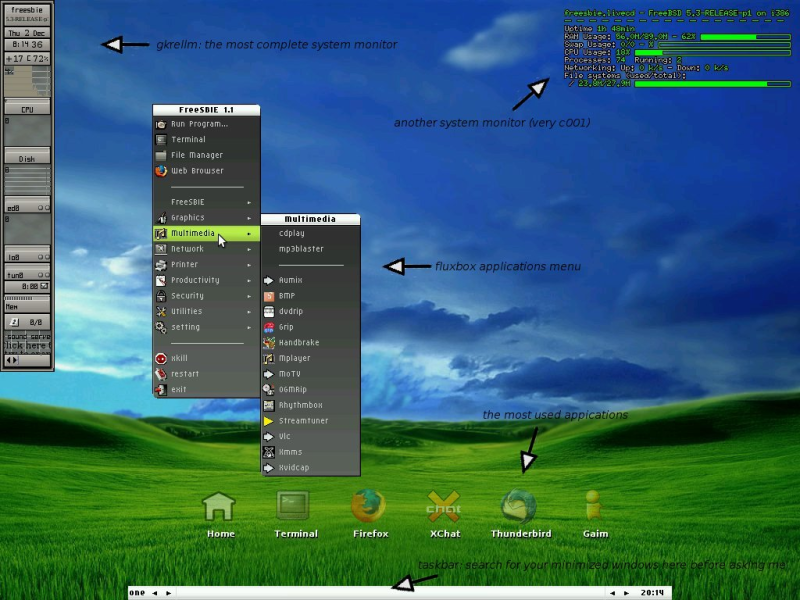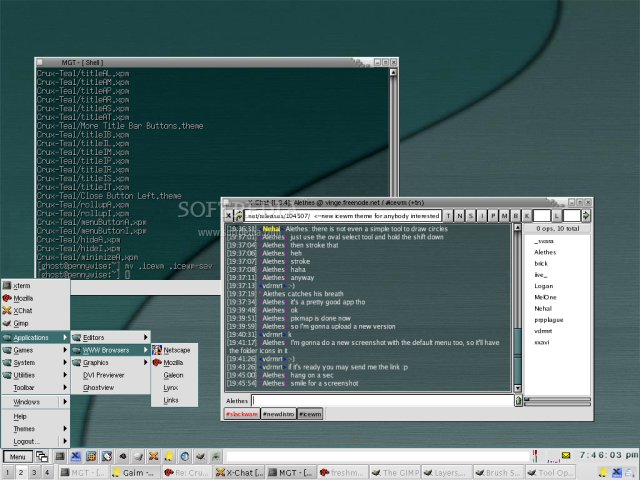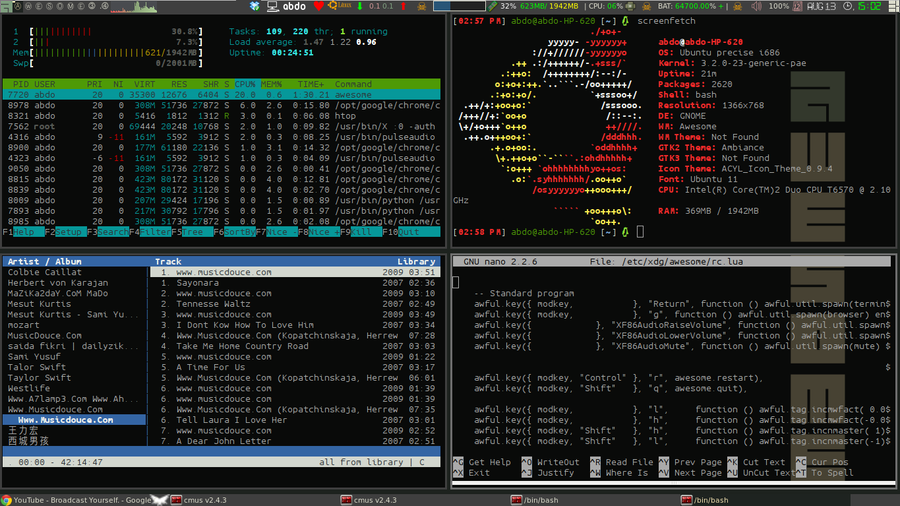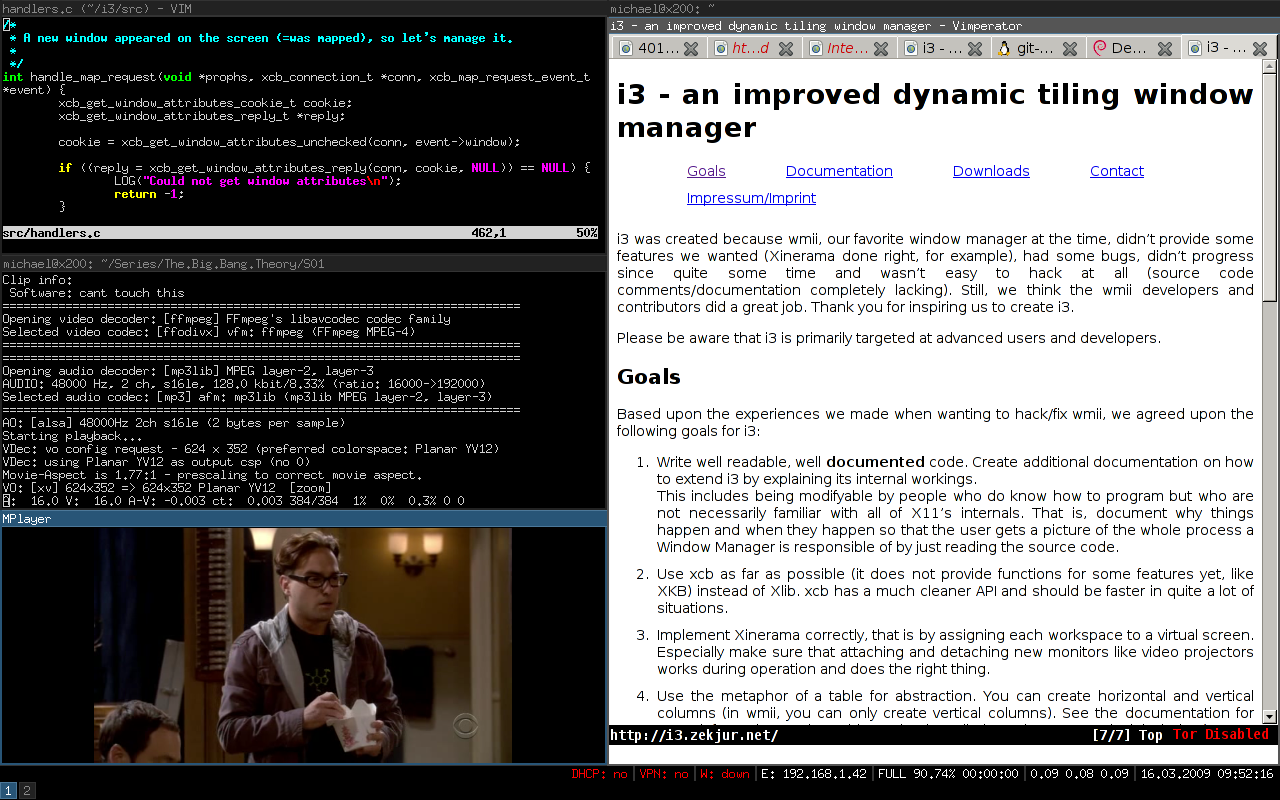Difference between revisions of "Install Desktop Environments/zh-cn"
Views
Actions
Namespaces
Variants
Tools
Xiaopangju (talk | contribs) (Created page with "Manjaro 有几种可用的桌面环境和窗口管理器,每种都有其独特的风格、界面和功能。另外,在有需求的情况下,可以安装多个桌面环...") Tags: Mobile web edit Mobile edit |
(Updating to match new version of source page) Tags: Mobile web edit Mobile edit |
||
| Line 5: | Line 5: | ||
== 简介 == | == 简介 == | ||
<div class="mw-translate-fuzzy"> | |||
Manjaro 有几种可用的桌面环境和窗口管理器,每种都有其独特的风格、界面和功能。另外,在有需求的情况下,可以安装多个桌面环境,可以在任何时候在登录界面切换。用户并不被限定使用预先安装的风格。 | Manjaro 有几种可用的桌面环境和窗口管理器,每种都有其独特的风格、界面和功能。另外,在有需求的情况下,可以安装多个桌面环境,可以在任何时候在登录界面切换。用户并不被限定使用预先安装的风格。 | ||
</div> | |||
| Line 11: | Line 13: | ||
= 桌面环境 = | = 桌面环境 = | ||
<div class="mw-translate-fuzzy"> | |||
值得注意的是,桌面环境(DE)不是独立存在的;它实际上是一起工作的不同组件的集合。这通常包括: | 值得注意的是,桌面环境(DE)不是独立存在的;它实际上是一起工作的不同组件的集合。这通常包括: | ||
</div> | |||
* '''窗口管理器''' 用于显示、移动和改变窗口尺寸 | * '''窗口管理器''' 用于显示、移动和改变窗口尺寸 | ||
| Line 20: | Line 24: | ||
<div lang="en" dir="ltr" class="mw-content-ltr"> | |||
And so on. Most desktop environments will also come with their own preferred applications, in addition to various widgets, addons, and extensions to provide extra features. As such, upon entering the commands provided below in your terminal to download and install a desktop environment, you may be prompted to choose from a selection of components provided for it. '''To install a full desktop environment''' - complete with its own preferred file manager, applications, and so on | And so on. Most desktop environments will also come with their own preferred applications, in addition to various widgets, addons, and extensions to provide extra features. As such, upon entering the commands provided below in your terminal to download and install a desktop environment, you may be prompted to choose from a selection of components provided for it. '''To install a full desktop environment''' - complete with its own preferred file manager, applications, and so on | ||
</div> | |||
<div lang="en" dir="ltr" class="mw-content-ltr"> | |||
Where additional (and optional) extras for a desktop environment are available, the terminal commands to obtain these have also been provided. | Where additional (and optional) extras for a desktop environment are available, the terminal commands to obtain these have also been provided. | ||
</div> | |||
<div lang="en" dir="ltr" class="mw-content-ltr"> | |||
Some important information about installing the Manjaro settings packages: | Some important information about installing the Manjaro settings packages: | ||
* The Manjaro settings packages contain the theming and settings to make the desktop the same as in the Manjaro ISOs | * The Manjaro settings packages contain the theming and settings to make the desktop the same as in the Manjaro ISOs | ||
| Line 29: | Line 38: | ||
* They share files so you can only have one at a time installed. | * They share files so you can only have one at a time installed. | ||
* If you are coming from gnome you must remove the meta package '''manjaro-gnome-assets''' before you can install the settings package for another desktop | * If you are coming from gnome you must remove the meta package '''manjaro-gnome-assets''' before you can install the settings package for another desktop | ||
</div> | |||
<div lang="en" dir="ltr" class="mw-content-ltr"> | |||
==The Risks of Using Multiple DEs== | ==The Risks of Using Multiple DEs== | ||
</div> | |||
<div lang="en" dir="ltr" class="mw-content-ltr"> | |||
Installing multiple DEs is not without risks. Here are some things that can pop-up when running more than one DE: | Installing multiple DEs is not without risks. Here are some things that can pop-up when running more than one DE: | ||
* The settings packages overlap so you can only have one DE pre-configured with the Manjaro theming. | * The settings packages overlap so you can only have one DE pre-configured with the Manjaro theming. The others will need to have the theming applied manually. | ||
* You can end up with more than one instance of similar applications. For example, it is common to end up with 2 Bluetooth managers. | * You can end up with more than one instance of similar applications. For example, it is common to end up with 2 Bluetooth managers. It takes some tweaking to get a single manager working in multiple DEs. | ||
* Sometimes two different DEs will share the same configuration files causing strange things to happen, especially with theming | * Sometimes two different DEs will share the same configuration files causing strange things to happen, especially with theming. | ||
</div> | |||
<div lang="en" dir="ltr" class="mw-content-ltr"> | |||
These risks are greatly reduced by using a different user account for each DE. | These risks are greatly reduced by using a different user account for each DE. | ||
</div> | |||
<div lang="en" dir="ltr" class="mw-content-ltr"> | |||
In summary, running multiple DEs is possible and a great way to enjoy Manjaro but it requires a willingness to troubleshoot and work through minor problems. If you are the type of person who wants everything to "just work" out of the box, running multiple DEs might not be for you. | In summary, running multiple DEs is possible and a great way to enjoy Manjaro but it requires a willingness to troubleshoot and work through minor problems. If you are the type of person who wants everything to "just work" out of the box, running multiple DEs might not be for you. | ||
</div> | |||
== | <div lang="en" dir="ltr" class="mw-content-ltr"> | ||
== Xfce == | |||
</div> | |||
<div lang="en" dir="ltr" class="mw-content-ltr"> | |||
[[File: xfceDE.png|thumb|left|375px]] | [[File: xfceDE.png|thumb|left|375px]] | ||
</div> | |||
'''[http://xfce.org/ XFCE | <div lang="en" dir="ltr" class="mw-content-ltr"> | ||
'''[http://xfce.org/ Xfce]''' or '''XFCE''', pronounced as four individual letters, is a lightweight and versatile desktop environment that utilises a classic drop-down/pop-up menu to access applications. It is also compatible with '''[[Compiz_and_Emerald|Compiz]]'''. A little time and effort will also be required to properly customise the desktop to suit personal taste. A 64 bit installation of Manjaro running Xfce uses about 390MB of memory. As of version 18, Manjaro has moved to the gtk3 version of Xfce. | |||
</div> | |||
====== Install a basic | <div lang="en" dir="ltr" class="mw-content-ltr"> | ||
====== Install a basic Xfce environment ====== | |||
</div> | |||
sudo pacman -S xfce4-gtk3 xfce4-goodies xfce4-terminal network-manager-applet xfce4-notifyd-gtk3 xfce4-whiskermenu-plugin-gtk3 tumbler engrampa | <div lang="en" dir="ltr" class="mw-content-ltr"> | ||
sudo pacman -S xfce4-gtk3 xfce4-goodies xfce4-terminal network-manager-applet xfce4-notifyd-gtk3 xfce4-whiskermenu-plugin-gtk3 tumbler engrampa | |||
</div> | |||
====== Optional: Install and use LightDM, the recommended display manager for | <div lang="en" dir="ltr" class="mw-content-ltr"> | ||
====== Optional: Install and use LightDM, the recommended display manager for Xfce ====== | |||
sudo pacman -S lightdm lightdm-gtk-greeter lightdm-gtk-greeter-settings | sudo pacman -S lightdm lightdm-gtk-greeter lightdm-gtk-greeter-settings | ||
sudo systemctl enable lightdm.service --force | sudo systemctl enable lightdm.service --force | ||
edit '''/etc/lightdm/lightdm.conf''', under [Seat:*] replace the greeter-session setting with '''greeter-session=lightdm-gtk-greeter''' | edit '''/etc/lightdm/lightdm.conf''', under [Seat:*] replace the greeter-session setting with '''greeter-session=lightdm-gtk-greeter''' | ||
</div> | |||
====== Optional: Install the Manjaro configuration and theming for | <div lang="en" dir="ltr" class="mw-content-ltr"> | ||
sudo pacman -S manjaro-xfce | ====== Optional: Install the Manjaro configuration and theming for Xfce ====== | ||
sudo pacman -S manjaro-xfce-settings manjaro-settings-manager | |||
</div> | |||
<div lang="en" dir="ltr" class="mw-content-ltr"> | |||
To configure LightDM to match the official iso replace the contents of /etc/lightdm/lightdm-gtk-greeter.conf with | To configure LightDM to match the official iso replace the contents of /etc/lightdm/lightdm-gtk-greeter.conf with | ||
[greeter] | [greeter] | ||
| Line 79: | Line 112: | ||
panel-position = bottom | panel-position = bottom | ||
indicators = ~host;~spacer;~clock;~spacer;~language;~session;~a11y;~power | indicators = ~host;~spacer;~clock;~spacer;~language;~session;~a11y;~power | ||
</div> | |||
<div lang="en" dir="ltr" class="mw-content-ltr"> | |||
====== Create a new user for the new desktop environment ====== | ====== Create a new user for the new desktop environment ====== | ||
sudo useradd -mG lp,network,power,sys,wheel <username> | sudo useradd -mG lp,network,power,sys,wheel <username> | ||
sudo passwd <username> | sudo passwd <username> | ||
</div> | |||
<div lang="en" dir="ltr" class="mw-content-ltr"> | |||
<br clear="all" /> | <br clear="all" /> | ||
</div> | |||
<div lang="en" dir="ltr" class="mw-content-ltr"> | |||
== KDE Plasma 5 == | == KDE Plasma 5 == | ||
[[File: KDEPlasmaDE.png|thumb|left|375px]] | [[File: KDEPlasmaDE.png|thumb|left|375px]] | ||
</div> | |||
<div lang="en" dir="ltr" class="mw-content-ltr"> | |||
'''[http://www.kde.org/ The KDE community]''' offers [https://www.kde.org/plasma-desktop Plasma], a feature-rich and versatile desktop environment that provides several different styles of menu to access applications. Its default window manager is kwin, but is also compatible with '''[[Compiz_and_Emerald|Compiz]]'''. An excellent built-in interface to easily access and install new themes, widgets, etc, from the internet is also worth mentioning. A 64 bit installation of Manjaro running KDE uses about 455MB of memory. | '''[http://www.kde.org/ The KDE community]''' offers [https://www.kde.org/plasma-desktop Plasma], a feature-rich and versatile desktop environment that provides several different styles of menu to access applications. Its default window manager is kwin, but is also compatible with '''[[Compiz_and_Emerald|Compiz]]'''. An excellent built-in interface to easily access and install new themes, widgets, etc, from the internet is also worth mentioning. A 64 bit installation of Manjaro running KDE uses about 455MB of memory. | ||
</div> | |||
<div lang="en" dir="ltr" class="mw-content-ltr"> | |||
====== Install a basic KDE Plasma environment ====== | ====== Install a basic KDE Plasma environment ====== | ||
</div> | |||
sudo pacman -S plasma kio-extras | <div lang="en" dir="ltr" class="mw-content-ltr"> | ||
sudo pacman -S plasma kio-extras | |||
</div> | |||
<div lang="en" dir="ltr" class="mw-content-ltr"> | |||
====== Optional: Install KDE applications ====== | ====== Optional: Install KDE applications ====== | ||
</div> | |||
<div lang="en" dir="ltr" class="mw-content-ltr"> | |||
To install a full set of K* applications use '''kde-applications'''. This will be ~300 packages(including dependencies) | To install a full set of K* applications use '''kde-applications'''. This will be ~300 packages(including dependencies) | ||
sudo pacman -S kde-applications | sudo pacman -S kde-applications | ||
</div> | |||
<div lang="en" dir="ltr" class="mw-content-ltr"> | |||
====== Optional: Install and use [https://wiki.manjaro.org/index.php?title=Install_Display_Managers#SDDM SDDM], the recommended display manager for KDE ====== | ====== Optional: Install and use [https://wiki.manjaro.org/index.php?title=Install_Display_Managers#SDDM SDDM], the recommended display manager for KDE ====== | ||
</div> | |||
<div lang="en" dir="ltr" class="mw-content-ltr"> | |||
SDDM is installed as a dependency of plasma. To enable it | SDDM is installed as a dependency of plasma. To enable it | ||
systemctl enable sddm.service --force | systemctl enable sddm.service --force | ||
systemctl reboot | systemctl reboot | ||
</div> | |||
<div lang="en" dir="ltr" class="mw-content-ltr"> | |||
====== Optional: Install the Manjaro configuration and theming for plasma ====== | ====== Optional: Install the Manjaro configuration and theming for plasma ====== | ||
sudo pacman -S manjaro-kde-settings sddm-breath-theme manjaro-settings-manager-knotifier manjaro-settings-manager-kcm | sudo pacman -S manjaro-kde-settings sddm-breath-theme manjaro-settings-manager-knotifier manjaro-settings-manager-kcm | ||
</div> | |||
<div lang="en" dir="ltr" class="mw-content-ltr"> | |||
Open plasma settings, go to Startup & Shutdown->Login Screen and select "Breath" | Open plasma settings, go to Startup & Shutdown->Login Screen and select "Breath" | ||
</div> | |||
<div lang="en" dir="ltr" class="mw-content-ltr"> | |||
Alternatively, the newer themes may be installed with: | Alternatively, the newer themes may be installed with: | ||
</div> | |||
sudo pacman -S | <div lang="en" dir="ltr" class="mw-content-ltr"> | ||
sudo pacman -S plasma5-themes-breath | |||
</div> | |||
<div lang="en" dir="ltr" class="mw-content-ltr"> | |||
====== Create a new user for the new desktop environment ====== | ====== Create a new user for the new desktop environment ====== | ||
sudo useradd -mG lp,network,power,sys,wheel <username> | sudo useradd -mG lp,network,power,sys,wheel <username> | ||
sudo passwd <username> | sudo passwd <username> | ||
</div> | |||
<div lang="en" dir="ltr" class="mw-content-ltr"> | |||
<br clear="all" /> | <br clear="all" /> | ||
</div> | |||
== | <div lang="en" dir="ltr" class="mw-content-ltr"> | ||
== GNOME 3 == | |||
[[File: Gnome-de-18.jpg|thumb|left|375px]] | [[File: Gnome-de-18.jpg|thumb|left|375px]] | ||
</div> | |||
'''[http://www.gnome.org/ | <div lang="en" dir="ltr" class="mw-content-ltr"> | ||
'''[http://www.gnome.org/ GNOME 3]''' is an intuitive desktop environment that utilises a tablet or smartphone style interface to access applications. It is not compatible with compiz. Although GNOME is very easy to learn and use, it has limited customisation options and it can be difficult to configure. A 64 bit installation of Manjaro running GNOME uses about 447MB of memory. | |||
</div> | |||
====== Install a basic | <div lang="en" dir="ltr" class="mw-content-ltr"> | ||
====== Install a basic GNOME environment ====== | |||
</div> | |||
sudo pacman -S gnome | <div lang="en" dir="ltr" class="mw-content-ltr"> | ||
sudo pacman -S gnome | |||
</div> | |||
<div lang="en" dir="ltr" class="mw-content-ltr"> | |||
====== Optional: To install extra themes, games, and features ====== | ====== Optional: To install extra themes, games, and features ====== | ||
</div> | |||
sudo pacman -S gnome-extra | <div lang="en" dir="ltr" class="mw-content-ltr"> | ||
sudo pacman -S gnome-extra | |||
</div> | |||
====== Optional: Install and use GDM, the recommended display manager for | <div lang="en" dir="ltr" class="mw-content-ltr"> | ||
====== Optional: Install and use GDM, the recommended display manager for GNOME ====== | |||
</div> | |||
GDM is installed as a dependency of | <div lang="en" dir="ltr" class="mw-content-ltr"> | ||
GDM is installed as a dependency of GNOME. To enable it: | |||
systemctl enable gdm.service --force | systemctl enable gdm.service --force | ||
</div> | |||
====== Optional: Install the Manjaro configuration and theming for | <div lang="en" dir="ltr" class="mw-content-ltr"> | ||
====== Optional: Install the Manjaro configuration and theming for GNOME ====== | |||
sudo pacman -S manjaro-gnome- | sudo pacman -S manjaro-gnome-settings manjaro-settings-manager | ||
</div> | |||
<div lang="en" dir="ltr" class="mw-content-ltr"> | |||
====== Create a new user for the new desktop environment ====== | ====== Create a new user for the new desktop environment ====== | ||
sudo useradd -mG lp,network,power,sys,wheel <username> | sudo useradd -mG lp,network,power,sys,wheel <username> | ||
sudo passwd <username> | sudo passwd <username> | ||
</div> | |||
<div lang="en" dir="ltr" class="mw-content-ltr"> | |||
<br clear="all" /> | <br clear="all" /> | ||
</div> | |||
<div lang="en" dir="ltr" class="mw-content-ltr"> | |||
== Budgie == | == Budgie == | ||
[[File: budgie.jpg|thumb|left|375px]] | [[File: budgie.jpg|thumb|left|375px]] | ||
</div> | |||
The '''[https://github.com/solus-project/budgie-desktop Budgie Desktop]''' is a modern desktop designed to keep out the way of the user. It features heavy integration with the GNOME stack in order for an enhanced experience. A 64 bit installation of Manjaro running | <div lang="en" dir="ltr" class="mw-content-ltr"> | ||
The '''[https://github.com/solus-project/budgie-desktop Budgie Desktop]''' is a modern desktop designed to keep out the way of the user. It features heavy integration with the GNOME stack in order for an enhanced experience. A 64 bit installation of Manjaro running Budgie uses about 632MB of memory. | |||
</div> | |||
====== Install a basic | <div lang="en" dir="ltr" class="mw-content-ltr"> | ||
====== Install a basic Budgie environment ====== | |||
</div> | |||
sudo pacman -S budgie-desktop network-manager-applet gnome-control-center gnome-screensaver | <div lang="en" dir="ltr" class="mw-content-ltr"> | ||
sudo pacman -S budgie-desktop network-manager-applet gnome-control-center gnome-screensaver | |||
</div> | |||
<div lang="en" dir="ltr" class="mw-content-ltr"> | |||
====== Optional: Install additional commonly used components ====== | ====== Optional: Install additional commonly used components ====== | ||
sudo pacman -S gnome-terminal nautilus budgie-extras dconf-editor | sudo pacman -S gnome-terminal nautilus budgie-extras dconf-editor | ||
</div> | |||
<div lang="en" dir="ltr" class="mw-content-ltr"> | |||
====== Optional: Install and use LightDM, the recommended display manager for budgie ====== | ====== Optional: Install and use LightDM, the recommended display manager for budgie ====== | ||
| Line 171: | Line 270: | ||
systemctl enable lightdm.service --force | systemctl enable lightdm.service --force | ||
edit ''/etc/lightdm/lightdm.conf'', under '''[Seat:*]''' replace the greeter-session setting with '''greeter-session=lightdm-slick-greeter''' | edit ''/etc/lightdm/lightdm.conf'', under '''[Seat:*]''' replace the greeter-session setting with '''greeter-session=lightdm-slick-greeter''' | ||
</div> | |||
====== Optional: Install the Manjaro configuration and theming for | <div lang="en" dir="ltr" class="mw-content-ltr"> | ||
====== Optional: Install the Manjaro configuration and theming for Budgie ====== | |||
sudo pacman -S manjaro-budgie-settings manjaro-settings-manager papirus-maia-icon-theme | sudo pacman -S manjaro-budgie-settings manjaro-settings-manager papirus-maia-icon-theme | ||
</div> | |||
<div lang="en" dir="ltr" class="mw-content-ltr"> | |||
To configure LightDM to match the official iso replace the contents of /etc/lightdm/slick-greeter.conf with | To configure LightDM to match the official iso replace the contents of /etc/lightdm/slick-greeter.conf with | ||
[Greeter] | [Greeter] | ||
| Line 182: | Line 285: | ||
icon-theme-name=Papirus-Maia | icon-theme-name=Papirus-Maia | ||
draw-grid=false | draw-grid=false | ||
</div> | |||
<div lang="en" dir="ltr" class="mw-content-ltr"> | |||
====== Create a new user for the new desktop environment ====== | ====== Create a new user for the new desktop environment ====== | ||
sudo useradd -mG lp,network,power,sys,wheel <username> | sudo useradd -mG lp,network,power,sys,wheel <username> | ||
sudo passwd <username> | sudo passwd <username> | ||
</div> | |||
<div lang="en" dir="ltr" class="mw-content-ltr"> | |||
<br clear="all" /> | <br clear="all" /> | ||
</div> | |||
<div lang="en" dir="ltr" class="mw-content-ltr"> | |||
== Cinnamon == | == Cinnamon == | ||
[[File: Cinnamon screenshot.jpeg|thumb|left|375px]] | [[File: Cinnamon screenshot.jpeg|thumb|left|375px]] | ||
</div> | |||
'''[http://cinnamon.linuxmint.com/ Cinnamon]''' is a desktop environment based on | <div lang="en" dir="ltr" class="mw-content-ltr"> | ||
'''[http://cinnamon.linuxmint.com/ Cinnamon]''' is a desktop environment based on GNOME 3 that utilises a large panel-style menu to access applications. It is not compatible with compiz. Despite being based on GNOME, it has more customisation options and therefore is easier to configure. Windows Vista or 7 users may find Cinnamon's interface comfortably familiar. A 64 bit installation of Manjaro running Cinnamon uses about 665MB of memory. | |||
</div> | |||
====== Install a basic | <div lang="en" dir="ltr" class="mw-content-ltr"> | ||
====== Install a basic Cinnamon environment ====== | |||
</div> | |||
sudo pacman -S cinnamon | <div lang="en" dir="ltr" class="mw-content-ltr"> | ||
sudo pacman -S cinnamon | |||
</div> | |||
<div lang="en" dir="ltr" class="mw-content-ltr"> | |||
====== Optional: Install additional commonly used components ====== | ====== Optional: Install additional commonly used components ====== | ||
sudo pacman -S cinnamon-wallpapers cinnamon-sounds gnome-terminal parcellite | sudo pacman -S cinnamon-wallpapers cinnamon-sounds gnome-terminal parcellite | ||
</div> | |||
<div lang="en" dir="ltr" class="mw-content-ltr"> | |||
====== Optional: Install and use LightDM, the recommended display manager for cinnamon ====== | ====== Optional: Install and use LightDM, the recommended display manager for cinnamon ====== | ||
sudo pacman -S lightdm lightdm-slick-greeter lightdm-settings | sudo pacman -S lightdm lightdm-slick-greeter lightdm-settings | ||
systemctl enable lightdm.service --force | systemctl enable lightdm.service --force | ||
</div> | |||
<div lang="en" dir="ltr" class="mw-content-ltr"> | |||
Then edit ''/etc/lightdm/lightdm.conf'', under '''[Seat:*]''' replace the greeter-session setting with '''greeter-session=lightdm-slick-greeter''' | Then edit ''/etc/lightdm/lightdm.conf'', under '''[Seat:*]''' replace the greeter-session setting with '''greeter-session=lightdm-slick-greeter''' | ||
</div> | |||
====== Optional: Install the Manjaro configuration and theming for | <div lang="en" dir="ltr" class="mw-content-ltr"> | ||
====== Optional: Install the Manjaro configuration and theming for Cinnamon ====== | |||
sudo pacman -S manjaro-cinnamon-settings adapta-maia-theme kvantum-manjaro | sudo pacman -S manjaro-cinnamon-settings adapta-maia-theme kvantum-manjaro | ||
</div> | |||
<div lang="en" dir="ltr" class="mw-content-ltr"> | |||
To configure LightDM to match the community edition replace the contents of /etc/lightdm/slick-greeter.conf with | To configure LightDM to match the community edition replace the contents of /etc/lightdm/slick-greeter.conf with | ||
[Greeter] | [Greeter] | ||
| Line 225: | Line 350: | ||
xft-hintstyle=hintfull | xft-hintstyle=hintfull | ||
enable-hidpi=auto | enable-hidpi=auto | ||
</div> | |||
<div lang="en" dir="ltr" class="mw-content-ltr"> | |||
Set the Manjaro logo on the panel by right-clicking on the menu and clicking configure. Select "Use a custom icon and label". Select the Manjaro icon. | Set the Manjaro logo on the panel by right-clicking on the menu and clicking configure. Select "Use a custom icon and label". Select the Manjaro icon. | ||
</div> | |||
<div lang="en" dir="ltr" class="mw-content-ltr"> | |||
====== Create a new user for the new desktop environment ====== | ====== Create a new user for the new desktop environment ====== | ||
sudo useradd -mG lp,network,power,sys,wheel <username> | sudo useradd -mG lp,network,power,sys,wheel <username> | ||
sudo passwd <username> | sudo passwd <username> | ||
</div> | |||
<div lang="en" dir="ltr" class="mw-content-ltr"> | |||
<br clear="all" /> | <br clear="all" /> | ||
</div> | |||
<div lang="en" dir="ltr" class="mw-content-ltr"> | |||
== Deepin == | == Deepin == | ||
[[File: deepin.jpg|thumb|left|375px]] | [[File: deepin.jpg|thumb|left|375px]] | ||
The '''[https://www.deepin.org/en/dde/ Deepin Desktop]''' is an elegant, easy to use desktop. It is lightly configurable. A 64 bit installation of Manjaro running | The '''[https://www.deepin.org/en/dde/ Deepin Desktop]''' is an elegant, easy to use desktop. It is lightly configurable. A 64 bit installation of Manjaro running Deepin uses about 525MB of memory. | ||
</div> | |||
<div lang="en" dir="ltr" class="mw-content-ltr"> | |||
====== Install a basic deepin environment ====== | ====== Install a basic deepin environment ====== | ||
</div> | |||
sudo pacman -S deepin | <div lang="en" dir="ltr" class="mw-content-ltr"> | ||
sudo pacman -S deepin | |||
</div> | |||
====== Optional: Install the | <div lang="en" dir="ltr" class="mw-content-ltr"> | ||
====== Optional: Install the Deepin applications suite ====== | |||
sudo pacman -S deepin-extra | sudo pacman -S deepin-extra | ||
</div> | |||
<div lang="en" dir="ltr" class="mw-content-ltr"> | |||
====== Optional: Install and use LightDM, the recommended display manager for deepin====== | ====== Optional: Install and use LightDM, the recommended display manager for deepin====== | ||
sudo pacman -S lightdm | sudo pacman -S lightdm | ||
systemctl enable lightdm.service --force | systemctl enable lightdm.service --force | ||
</div> | |||
<div lang="en" dir="ltr" class="mw-content-ltr"> | |||
Then edit ''/etc/lightdm/lightdm.conf'', under '''[Seat:*]''' replace the greeter-session setting with '''greeter-session=lightdm-deepin-greeter''' | Then edit ''/etc/lightdm/lightdm.conf'', under '''[Seat:*]''' replace the greeter-session setting with '''greeter-session=lightdm-deepin-greeter''' | ||
</div> | |||
====== Optional: Install the Manjaro configuration and theming for | <div lang="en" dir="ltr" class="mw-content-ltr"> | ||
====== Optional: Install the Manjaro configuration and theming for Deepin ====== | |||
sudo pacman -S deepin-manjaro | sudo pacman -S deepin-manjaro | ||
</div> | |||
<div lang="en" dir="ltr" class="mw-content-ltr"> | |||
====== Create a new user for the new desktop environment ====== | ====== Create a new user for the new desktop environment ====== | ||
sudo useradd -mG lp,network,power,sys,wheel <username> | sudo useradd -mG lp,network,power,sys,wheel <username> | ||
sudo passwd <username> | sudo passwd <username> | ||
</div> | |||
<div lang="en" dir="ltr" class="mw-content-ltr"> | |||
<br clear="all" /> | <br clear="all" /> | ||
</div> | |||
<div lang="en" dir="ltr" class="mw-content-ltr"> | |||
== Enlightenment == | == Enlightenment == | ||
{{note|There is not currently a Manjaro settings package for Enlightenment|}} | {{note|There is not currently a Manjaro settings package for Enlightenment|}} | ||
[[File: E20-Green_Onix_760.png|thumb|left|375px]] | [[File: E20-Green_Onix_760.png|thumb|left|375px]] | ||
</div> | |||
'''[http://www.enlightenment.org/ Enlightenment]''', sometimes known simply as E, is a lightweight desktop environment known for its configurability and tools for creating beautiful user interfaces using its Enlightenment Foundation Libraries (EFL). E started in 1997 as a stacking | <div lang="en" dir="ltr" class="mw-content-ltr"> | ||
'''[http://www.enlightenment.org/ Enlightenment]''', sometimes known simply as E, is a lightweight desktop environment known for its configurability and tools for creating beautiful user interfaces using its Enlightenment Foundation Libraries (EFL). E started in 1997 as a stacking window manager, emerging as a desktop environment since development release version 0.17. E does not come with a broad array of tools by default, which can be an advantage for experienced users who want to customize their installation, and a disadvantage for users with little or no experience of Linux. E uses a few unique terms, for example referring to panels as “shelves”. A 64-bit installation of E uses about 160M of memory. | |||
</div> | |||
<div lang="en" dir="ltr" class="mw-content-ltr"> | |||
====== Install a basic E environment ====== | ====== Install a basic E environment ====== | ||
sudo pacman -S enlightenment | sudo pacman -S enlightenment | ||
</div> | |||
<div lang="en" dir="ltr" class="mw-content-ltr"> | |||
====== Optional: Install and use Entrance, the recommended display manager for E ====== | ====== Optional: Install and use Entrance, the recommended display manager for E ====== | ||
Entrance is available from the AUR in the package '''entrance-git'''. Information on how to install packages from AUR can be found '''[https://wiki.manjaro.org/index.php/Arch_User_Repository here]'''. | Entrance is available from the AUR in the package '''entrance-git'''. Information on how to install packages from AUR can be found '''[https://wiki.manjaro.org/index.php/Arch_User_Repository here]'''. | ||
| Line 280: | Line 437: | ||
$ pamac build entrance-git | $ pamac build entrance-git | ||
$ sudo systemctl enable entrance.service --force | $ sudo systemctl enable entrance.service --force | ||
</div> | |||
<div lang="en" dir="ltr" class="mw-content-ltr"> | |||
====== Optional: Install Manjaro themes for E ====== | ====== Optional: Install Manjaro themes for E ====== | ||
sudo pacman -S enlightenment-manjaro-themes | sudo pacman -S enlightenment-manjaro-themes | ||
</div> | |||
<div lang="en" dir="ltr" class="mw-content-ltr"> | |||
====== Create a new user for the new desktop environment ====== | ====== Create a new user for the new desktop environment ====== | ||
sudo useradd -mG lp,network,power,sys,wheel <username> | sudo useradd -mG lp,network,power,sys,wheel <username> | ||
sudo passwd <username> | sudo passwd <username> | ||
</div> | |||
<div lang="en" dir="ltr" class="mw-content-ltr"> | |||
<br clear="all" /> | <br clear="all" /> | ||
</div> | |||
<div lang="en" dir="ltr" class="mw-content-ltr"> | |||
== LXDE == | == LXDE == | ||
</div> | |||
<div lang="en" dir="ltr" class="mw-content-ltr"> | |||
{{Note|Installing LXDE will also result in installing ''Openbox'' as its default window manager. The LXDM display manager will also be downloaded, although it will be necessary to enable this yourself if you wish to replace your existing display manager.}} | {{Note|Installing LXDE will also result in installing ''Openbox'' as its default window manager. The LXDM display manager will also be downloaded, although it will be necessary to enable this yourself if you wish to replace your existing display manager.}} | ||
[[File: lxde17.1.11.jpg|thumb|left|375px]] | [[File: lxde17.1.11.jpg|thumb|left|375px]] | ||
</div> | |||
'''[http://lxde.org/ LXDE]''' is a super-lightweight desktop environment that is very similar to XFCE, with the exception that it is not compatible with Compiz. As with XFCE, LXDE is also a somewhat basic desktop environment, lacking some modern features that would be expected, such as a search-bar to find applications and files. However, it is also an excellent choice for less powerful computers. | <div lang="en" dir="ltr" class="mw-content-ltr"> | ||
'''[http://lxde.org/ LXDE]''' is a super-lightweight desktop environment that is very similar to XFCE, with the exception that it is not compatible with Compiz. As with XFCE, LXDE is also a somewhat basic desktop environment, lacking some modern features that would be expected, such as a search-bar to find applications and files. However, due to comparatively low resource requirements, it is also an excellent choice for less powerful computers. | |||
</div> | |||
====== Install a basic | <div lang="en" dir="ltr" class="mw-content-ltr"> | ||
====== Install a basic LXDE environment ====== | |||
</div> | |||
sudo pacman -S lxde network-manager-applet | <div lang="en" dir="ltr" class="mw-content-ltr"> | ||
sudo pacman -S lxde network-manager-applet | |||
</div> | |||
<div lang="en" dir="ltr" class="mw-content-ltr"> | |||
====== Optional: Install and use LightDM, the recommended display manager for lxde ====== | ====== Optional: Install and use LightDM, the recommended display manager for lxde ====== | ||
sudo pacman -S lightdm lightdm-gtk-greeter lightdm-gtk-greeter-settings | sudo pacman -S lightdm lightdm-gtk-greeter lightdm-gtk-greeter-settings | ||
systemctl enable lightdm.service --force | systemctl enable lightdm.service --force | ||
</div> | |||
<div lang="en" dir="ltr" class="mw-content-ltr"> | |||
====== Optional: Install the Manjaro configuration and theming for lxde ====== | ====== Optional: Install the Manjaro configuration and theming for lxde ====== | ||
sudo pacman -S manjaro-lxde-logout-banner manjaro-lxde-xfce4-notifyd manjaro-lxde-xfce4-volumed-pulse manjaro-settings-manager manjaro-settings-manager-notifier manjaro-lxde-settings arc-maia-icon-theme kvantum-manjaro | sudo pacman -S manjaro-lxde-logout-banner manjaro-lxde-xfce4-notifyd manjaro-lxde-xfce4-volumed-pulse manjaro-settings-manager manjaro-settings-manager-notifier manjaro-lxde-settings arc-maia-icon-theme kvantum-manjaro | ||
</div> | |||
<div lang="en" dir="ltr" class="mw-content-ltr"> | |||
To configure LightDM to match the community edition replace the contents of /etc/lightdm/lightdm-gtk-greeter.conf with | To configure LightDM to match the community edition replace the contents of /etc/lightdm/lightdm-gtk-greeter.conf with | ||
[greeter] | [greeter] | ||
| Line 325: | Line 504: | ||
clock-format = | clock-format = | ||
panel-position = bottom | panel-position = bottom | ||
</div> | |||
<div lang="en" dir="ltr" class="mw-content-ltr"> | |||
====== Create a new user for the new desktop environment ====== | ====== Create a new user for the new desktop environment ====== | ||
sudo useradd -mG lp,network,power,sys,wheel <username> | sudo useradd -mG lp,network,power,sys,wheel <username> | ||
sudo passwd <username> | sudo passwd <username> | ||
</div> | |||
<div lang="en" dir="ltr" class="mw-content-ltr"> | |||
<br clear="all" /> | <br clear="all" /> | ||
</div> | |||
<div lang="en" dir="ltr" class="mw-content-ltr"> | |||
== LXQt == | == LXQt == | ||
</div> | |||
<div lang="en" dir="ltr" class="mw-content-ltr"> | |||
[[File: Lxqt-de-18.png|thumb|left|375px]] | [[File: Lxqt-de-18.png|thumb|left|375px]] | ||
</div> | |||
The '''[https://lxqt.org/ LXQt Desktop Environment]''' LXQt is a lightweight Qt desktop environment. It | <div lang="en" dir="ltr" class="mw-content-ltr"> | ||
The '''[https://lxqt.org/ LXQt Desktop Environment]''' LXQt is a lightweight Qt desktop environment. It was formed from the merger of the LXDE and Razor-qt projects. A 64 bit installation of Manjaro running lxqt uses about 250MB of memory. | |||
</div> | |||
<div lang="en" dir="ltr" class="mw-content-ltr"> | |||
====== Install a basic LXQt environment ====== | ====== Install a basic LXQt environment ====== | ||
sudo pacman -S lxqt xscreensaver | sudo pacman -S lxqt xscreensaver | ||
</div> | |||
<div lang="en" dir="ltr" class="mw-content-ltr"> | |||
====== Install and use LightDM, the recommended display manager for LXQt ====== | ====== Install and use LightDM, the recommended display manager for LXQt ====== | ||
sudo pacman -S lightdm lightdm-slick-greeter lightdm-settings light-locker | sudo pacman -S lightdm lightdm-slick-greeter lightdm-settings light-locker | ||
systemctl enable lightdm.service --force | systemctl enable lightdm.service --force | ||
edit /etc/lightdm/lightdm.conf, under [Seat:*] replace the greeter-session setting with greeter-session=lightdm-slick-greeter | edit /etc/lightdm/lightdm.conf, under [Seat:*] replace the greeter-session setting with greeter-session=lightdm-slick-greeter | ||
</div> | |||
<div lang="en" dir="ltr" class="mw-content-ltr"> | |||
====== Optional: Install the Manjaro configuration and theming for LXQt ====== | ====== Optional: Install the Manjaro configuration and theming for LXQt ====== | ||
sudo pacman -S manjaro-lxqt-extra-settings manjaro-openbox-adapta-maia papirus-maia-icon-theme | sudo pacman -S manjaro-lxqt-extra-settings manjaro-openbox-adapta-maia papirus-maia-icon-theme | ||
</div> | |||
<div lang="en" dir="ltr" class="mw-content-ltr"> | |||
====== Create a new user for the new desktop environment ====== | ====== Create a new user for the new desktop environment ====== | ||
sudo useradd -mG lp,network,power,sys,wheel <username> | sudo useradd -mG lp,network,power,sys,wheel <username> | ||
sudo passwd <username> | sudo passwd <username> | ||
</div> | |||
<div lang="en" dir="ltr" class="mw-content-ltr"> | |||
<br clear="all" /> | <br clear="all" /> | ||
</div> | |||
<div lang="en" dir="ltr" class="mw-content-ltr"> | |||
== MATE == | == MATE == | ||
</div> | |||
<div lang="en" dir="ltr" class="mw-content-ltr"> | |||
[[File: mate.jpg|thumb|left|375px]] | [[File: mate.jpg|thumb|left|375px]] | ||
</div> | |||
<div lang="en" dir="ltr" class="mw-content-ltr"> | |||
'''[https://mate-desktop.org/ MATE]''' is a desktop environment and the continuation of GNOME 2. Featuring an intuitive and attractive desktop environment while preserving a traditional desktop experience, its aim is to maintain and continue the latest GNOME 2 code base, frameworks, and core applications. A 64 bit installation of Manjaro running MATE uses about 378MB of memory. | |||
</div> | |||
====== Install a basic | <div lang="en" dir="ltr" class="mw-content-ltr"> | ||
====== Install a basic MATE environment ====== | |||
</div> | |||
sudo pacman -S mate network-manager-applet | <div lang="en" dir="ltr" class="mw-content-ltr"> | ||
sudo pacman -S mate network-manager-applet | |||
</div> | |||
====== Optional: Install | <div lang="en" dir="ltr" class="mw-content-ltr"> | ||
====== Optional: Install MATE applications and configuration tools ====== | |||
sudo pacman -S mate-extra dconf-editor | sudo pacman -S mate-extra dconf-editor | ||
</div> | |||
====== Optional: Install and use LightDM, the recommended display manager for | <div lang="en" dir="ltr" class="mw-content-ltr"> | ||
====== Optional: Install and use LightDM, the recommended display manager for MATE ====== | |||
sudo pacman -S lightdm lightdm-slick-greeter lightdm-settings | sudo pacman -S lightdm lightdm-slick-greeter lightdm-settings | ||
systemctl enable lightdm.service --force | systemctl enable lightdm.service --force | ||
edit '''/etc/lightdm/lightdm.conf''', under [Seat:*] replace the greeter-session setting with '''greeter-session=lightdm-slick-greeter''' | edit '''/etc/lightdm/lightdm.conf''', under [Seat:*] replace the greeter-session setting with '''greeter-session=lightdm-slick-greeter''' | ||
</div> | |||
====== Optional: Install the Manjaro configuration and theming for | <div lang="en" dir="ltr" class="mw-content-ltr"> | ||
====== Optional: Install the Manjaro configuration and theming for MATE ====== | |||
sudo pacman -S manjaro-mate-settings arc-maia-icon-theme papirus-maia-icon-theme manjaro-settings-manager manjaro-settings-manager-notifier | sudo pacman -S manjaro-mate-settings arc-maia-icon-theme papirus-maia-icon-theme manjaro-settings-manager manjaro-settings-manager-notifier | ||
</div> | |||
<div lang="en" dir="ltr" class="mw-content-ltr"> | |||
To configure LightDM to match the community edition replace the contents of /etc/lightdm/slick-greeter.conf with | To configure LightDM to match the community edition replace the contents of /etc/lightdm/slick-greeter.conf with | ||
[Greeter] | [Greeter] | ||
| Line 384: | Line 601: | ||
icon-theme-name=Arc-Maia | icon-theme-name=Arc-Maia | ||
draw-grid=false | draw-grid=false | ||
</div> | |||
<div lang="en" dir="ltr" class="mw-content-ltr"> | |||
====== Create a new user for the new desktop environment ====== | ====== Create a new user for the new desktop environment ====== | ||
sudo useradd -mG lp,network,power,sys,wheel <username> | sudo useradd -mG lp,network,power,sys,wheel <username> | ||
sudo passwd <username> | sudo passwd <username> | ||
</div> | |||
<div lang="en" dir="ltr" class="mw-content-ltr"> | |||
<br clear="all" /> | <br clear="all" /> | ||
</div> | |||
<div lang="en" dir="ltr" class="mw-content-ltr"> | |||
= Window Managers = | = Window Managers = | ||
</div> | |||
<div lang="en" dir="ltr" class="mw-content-ltr"> | |||
{{note|By nature, building your own desktop environment from a Window Manager will take substantially more time and effort than simply downloading a pre-defined desktop environment.}} | {{note|By nature, building your own desktop environment from a Window Manager will take substantially more time and effort than simply downloading a pre-defined desktop environment.}} | ||
</div> | |||
<div lang="en" dir="ltr" class="mw-content-ltr"> | |||
{{warning|The images provided below are purely for illustrative purposes only. You will have you put in the necessary time and effort to configure them.}} | {{warning|The images provided below are purely for illustrative purposes only. You will have you put in the necessary time and effort to configure them.}} | ||
</div> | |||
Although | <div lang="en" dir="ltr" class="mw-content-ltr"> | ||
Although desktop environments commonly provide a good range of customisation options to suit personal taste and preference, they may still be seen as somewhat restrictive or controlled in the sense that they merely allow for the personalisation of their pre-defined components. However, certain Window Managers (WM) empower users to take a 'do it yourself' approach in order to create their own desktop environments. In essence, they may be used as a foundation on which to build upon, as literally every component and every aspect of the desktop is under the direct control and choice of the user. An environment may be as elaborate or as minimalistic as desired, and it is even possible to mix and match various components from other desktop environments. | |||
</div> | |||
<div lang="en" dir="ltr" class="mw-content-ltr"> | |||
Therefore extremely powerful and versatile, these window managers also carry the additional benefit of being faster and more resource efficient than pre-defined desktop environments. Interestingly, the super-lightweight LXDE environment is itself built on the Openbox window manager. There are two types of Window Manager: '''Stacking''' and '''Tiling'''. These names denote how application windows will behave on your desktop. | Therefore extremely powerful and versatile, these window managers also carry the additional benefit of being faster and more resource efficient than pre-defined desktop environments. Interestingly, the super-lightweight LXDE environment is itself built on the Openbox window manager. There are two types of Window Manager: '''Stacking''' and '''Tiling'''. These names denote how application windows will behave on your desktop. | ||
</div> | |||
<div lang="en" dir="ltr" class="mw-content-ltr"> | |||
== Stacking Window Managers == | == Stacking Window Managers == | ||
</div> | |||
'''Stacking window managers''' are by far the most popular, and essentially allow application windows to be moved freely around the screen, which may overlap - or 'stack' - upon one another, hence the name. All popular desktop environments | <div lang="en" dir="ltr" class="mw-content-ltr"> | ||
'''Stacking window managers''' are by far the most popular, and essentially allow application windows to be moved freely around the screen, which may overlap - or 'stack' - upon one another, hence the name. All popular desktop environments such as Xfce, KDE Plasma and GNOME use stacking window Managers. | |||
</div> | |||
<div lang="en" dir="ltr" class="mw-content-ltr"> | |||
=== Openbox === | === Openbox === | ||
</div> | |||
<div lang="en" dir="ltr" class="mw-content-ltr"> | |||
[[File: manjarobox.png|thumb|left|375px]] | [[File: manjarobox.png|thumb|left|375px]] | ||
</div> | |||
<div lang="en" dir="ltr" class="mw-content-ltr"> | |||
'''[http://openbox.org/ Openbox]''' is by far the most popular Window Manager available. Due to its popularity there is excellent documentation available, as well as a good choice of additional themes that may be downloaded. '''To install Openbox, enter the command:''' | '''[http://openbox.org/ Openbox]''' is by far the most popular Window Manager available. Due to its popularity there is excellent documentation available, as well as a good choice of additional themes that may be downloaded. '''To install Openbox, enter the command:''' | ||
</div> | |||
sudo pacman -S openbox | <div lang="en" dir="ltr" class="mw-content-ltr"> | ||
sudo pacman -S openbox | |||
</div> | |||
<div lang="en" dir="ltr" class="mw-content-ltr"> | |||
To install a logout script, configuration application, menu-editor, and extra themes for Openbox, enter the following command: | To install a logout script, configuration application, menu-editor, and extra themes for Openbox, enter the following command: | ||
</div> | |||
sudo pacman -S oblogout obconf lxappearance-obconf-gtk3 obmenu openbox-themes-extra | <div lang="en" dir="ltr" class="mw-content-ltr"> | ||
sudo pacman -S oblogout obconf lxappearance-obconf-gtk3 obmenu openbox-themes-extra | |||
</div> | |||
<div lang="en" dir="ltr" class="mw-content-ltr"> | |||
====== Optional: Install the Manjaro configuration, theming, and tools for Openbox ====== | ====== Optional: Install the Manjaro configuration, theming, and tools for Openbox ====== | ||
</div> | |||
sudo pacman -S oblogout-manjaro manjaro-openbox-config manjaro-openbox-scripts manjaro-openbox-fonts matcha-gtk-theme | <div lang="en" dir="ltr" class="mw-content-ltr"> | ||
sudo pacman -S oblogout-manjaro manjaro-openbox-config manjaro-openbox-scripts manjaro-openbox-fonts matcha-gtk-theme | |||
<br clear="all" /> | <br clear="all" /> | ||
</div> | |||
<div lang="en" dir="ltr" class="mw-content-ltr"> | |||
=== FluxBox === | === FluxBox === | ||
</div> | |||
<div lang="en" dir="ltr" class="mw-content-ltr"> | |||
[[File: fluxbox2.png|thumb|left|375px]] | [[File: fluxbox2.png|thumb|left|375px]] | ||
</div> | |||
<div lang="en" dir="ltr" class="mw-content-ltr"> | |||
'''[http://fluxbox.org/ FluxBox]''' is another popular Window Manager. It is particularly notable for providing some features not seen in Openbox, such as ''tabbing'', which allows for windows to be grouped together. '''To install FluxBox, enter the command''': | '''[http://fluxbox.org/ FluxBox]''' is another popular Window Manager. It is particularly notable for providing some features not seen in Openbox, such as ''tabbing'', which allows for windows to be grouped together. '''To install FluxBox, enter the command''': | ||
</div> | |||
sudo pacman -S fluxbox | <div lang="en" dir="ltr" class="mw-content-ltr"> | ||
sudo pacman -S fluxbox | |||
</div> | |||
<div lang="en" dir="ltr" class="mw-content-ltr"> | |||
====== Optional: Install the newsfetcher and workspace pager for Fluxbox ====== | ====== Optional: Install the newsfetcher and workspace pager for Fluxbox ====== | ||
</div> | |||
sudo pacman -S fbnews fluxter | <div lang="en" dir="ltr" class="mw-content-ltr"> | ||
sudo pacman -S fbnews fluxter | |||
</div> | |||
<div lang="en" dir="ltr" class="mw-content-ltr"> | |||
====== Optional: Install the Manjaro configuration, theming, and tools for Fluxbox ====== | ====== Optional: Install the Manjaro configuration, theming, and tools for Fluxbox ====== | ||
</div> | |||
sudo pacman -S fbmenu-manjaro oblogout-manjaro artwork-fluxbox fluxboxtheme-manjaro | <div lang="en" dir="ltr" class="mw-content-ltr"> | ||
sudo pacman -S fbmenu-manjaro oblogout-manjaro artwork-fluxbox fluxboxtheme-manjaro | |||
<br clear="all" /> | <br clear="all" /> | ||
</div> | |||
<div lang="en" dir="ltr" class="mw-content-ltr"> | |||
=== IceWM === | === IceWM === | ||
</div> | |||
<div lang="en" dir="ltr" class="mw-content-ltr"> | |||
[[File: icewm2.jpg|thumb|left|375px]] | [[File: icewm2.jpg|thumb|left|375px]] | ||
</div> | |||
<div lang="en" dir="ltr" class="mw-content-ltr"> | |||
'''[https://www.ice-wm.org/ IceWM]''' is a Window Manager notable for perhaps being closer to a full desktop environment than Openbox or FluxBox. This includes providing a panel complete with menu, in addition to a workspace switcher. '''To install IceWM, enter the command''': | '''[https://www.ice-wm.org/ IceWM]''' is a Window Manager notable for perhaps being closer to a full desktop environment than Openbox or FluxBox. This includes providing a panel complete with menu, in addition to a workspace switcher. '''To install IceWM, enter the command''': | ||
</div> | |||
sudo pacman -S icewm | <div lang="en" dir="ltr" class="mw-content-ltr"> | ||
sudo pacman -S icewm | |||
</div> | |||
<div lang="en" dir="ltr" class="mw-content-ltr"> | |||
To install a suite of tools and themes specifically for IceWM, enter the command: | To install a suite of tools and themes specifically for IceWM, enter the command: | ||
</div> | |||
sudo pacman -S icewm-utils icewm-themes | <div lang="en" dir="ltr" class="mw-content-ltr"> | ||
sudo pacman -S icewm-utils icewm-themes | |||
<br clear="all" /> | <br clear="all" /> | ||
</div> | |||
<div lang="en" dir="ltr" class="mw-content-ltr"> | |||
== Tiling Window Managers == | == Tiling Window Managers == | ||
</div> | |||
<div lang="en" dir="ltr" class="mw-content-ltr"> | |||
'''Tiling window managers''' - as the name would suggest - tile application windows; each will have their own place on the screen, just like conventional tiles do not overlap. However, unlike conventional tiling, these window managers are usually very flexible, and allow for a multitude of different tiling patterns to suit personal taste and preference. Where stacking window managers focus on using the mouse for navigation, tiling window managers focus on the utilisation of the keyboard instead. As such, they can be much faster to use. | '''Tiling window managers''' - as the name would suggest - tile application windows; each will have their own place on the screen, just like conventional tiles do not overlap. However, unlike conventional tiling, these window managers are usually very flexible, and allow for a multitude of different tiling patterns to suit personal taste and preference. Where stacking window managers focus on using the mouse for navigation, tiling window managers focus on the utilisation of the keyboard instead. As such, they can be much faster to use. | ||
</div> | |||
<div lang="en" dir="ltr" class="mw-content-ltr"> | |||
=== Awesome === | === Awesome === | ||
</div> | |||
<div lang="en" dir="ltr" class="mw-content-ltr"> | |||
[[File: awesome.png|thumb|left|375px]] | [[File: awesome.png|thumb|left|375px]] | ||
</div> | |||
<div lang="en" dir="ltr" class="mw-content-ltr"> | |||
'''[http://awesome.naquadah.org/ Awesome]''' is a popular tiling Window Manager, notable for using the '''Lua''' language for configuration. '''To install Awesome, enter the command''': | '''[http://awesome.naquadah.org/ Awesome]''' is a popular tiling Window Manager, notable for using the '''Lua''' language for configuration. '''To install Awesome, enter the command''': | ||
</div> | |||
sudo pacman -S awesome | <div lang="en" dir="ltr" class="mw-content-ltr"> | ||
sudo pacman -S awesome | |||
</div> | |||
<div lang="en" dir="ltr" class="mw-content-ltr"> | |||
To install some extra widgets for Awesome, enter the command: | To install some extra widgets for Awesome, enter the command: | ||
</div> | |||
sudo pacman -S vicious | <div lang="en" dir="ltr" class="mw-content-ltr"> | ||
sudo pacman -S vicious | |||
</div> | |||
<div lang="en" dir="ltr" class="mw-content-ltr"> | |||
Alternatively you can install the [[Awesome Community Edition]]. | Alternatively you can install the [[Awesome Community Edition]]. | ||
<br clear="all" /> | <br clear="all" /> | ||
</div> | |||
<div lang="en" dir="ltr" class="mw-content-ltr"> | |||
=== i3 === | === i3 === | ||
</div> | |||
<div lang="en" dir="ltr" class="mw-content-ltr"> | |||
[[File: i3wm.png|thumb|left|375px]] | [[File: i3wm.png|thumb|left|375px]] | ||
</div> | |||
<div lang="en" dir="ltr" class="mw-content-ltr"> | |||
'''[http://i3wm.org/ i3]''' is arguably the most popular tiling window manager available, and notable for using a single, completely self-contained configuration file. '''To install i3, enter the command''': | '''[http://i3wm.org/ i3]''' is arguably the most popular tiling window manager available, and notable for using a single, completely self-contained configuration file. '''To install i3, enter the command''': | ||
</div> | |||
sudo pacman -S i3-wm | <div lang="en" dir="ltr" class="mw-content-ltr"> | ||
sudo pacman -S i3-wm | |||
</div> | |||
<div lang="en" dir="ltr" class="mw-content-ltr"> | |||
To install a status bar and screen-locker for i3, enter the command: | To install a status bar and screen-locker for i3, enter the command: | ||
</div> | |||
sudo pacman -S i3lock i3status | <div lang="en" dir="ltr" class="mw-content-ltr"> | ||
sudo pacman -S i3lock i3status | |||
<br clear="all" /> | <br clear="all" /> | ||
</div> | |||
[[Category:Contents Page{{#translation:}}]] | [[Category:Contents Page{{#translation:}}]] | ||
[[Category:Editions{{#translation:}}]] | [[Category:Editions{{#translation:}}]] | ||
Revision as of 05:27, 11 January 2023
简介
Manjaro 有几种可用的桌面环境和窗口管理器,每种都有其独特的风格、界面和功能。另外,在有需求的情况下,可以安装多个桌面环境,可以在任何时候在登录界面切换。用户并不被限定使用预先安装的风格。
桌面环境
值得注意的是,桌面环境(DE)不是独立存在的;它实际上是一起工作的不同组件的集合。这通常包括:
- 窗口管理器 用于显示、移动和改变窗口尺寸
- 文件管理器 用于在图形化界面中浏览、复制和访问文件等
- 背景显示器 用于显示壁纸等
- 面板 提供菜单以显示信息(例如时间)
- 设置/配置管理器 改变桌面环境的外观
And so on. Most desktop environments will also come with their own preferred applications, in addition to various widgets, addons, and extensions to provide extra features. As such, upon entering the commands provided below in your terminal to download and install a desktop environment, you may be prompted to choose from a selection of components provided for it. To install a full desktop environment - complete with its own preferred file manager, applications, and so on
Where additional (and optional) extras for a desktop environment are available, the terminal commands to obtain these have also been provided.
Some important information about installing the Manjaro settings packages:
- The Manjaro settings packages contain the theming and settings to make the desktop the same as in the Manjaro ISOs
- They have the naming convention manjaro-<desktop>-settings i.e. manjaro-xfce-settings
- They share files so you can only have one at a time installed.
- If you are coming from gnome you must remove the meta package manjaro-gnome-assets before you can install the settings package for another desktop
The Risks of Using Multiple DEs
Installing multiple DEs is not without risks. Here are some things that can pop-up when running more than one DE:
- The settings packages overlap so you can only have one DE pre-configured with the Manjaro theming. The others will need to have the theming applied manually.
- You can end up with more than one instance of similar applications. For example, it is common to end up with 2 Bluetooth managers. It takes some tweaking to get a single manager working in multiple DEs.
- Sometimes two different DEs will share the same configuration files causing strange things to happen, especially with theming.
These risks are greatly reduced by using a different user account for each DE.
In summary, running multiple DEs is possible and a great way to enjoy Manjaro but it requires a willingness to troubleshoot and work through minor problems. If you are the type of person who wants everything to "just work" out of the box, running multiple DEs might not be for you.
Xfce
Xfce or XFCE, pronounced as four individual letters, is a lightweight and versatile desktop environment that utilises a classic drop-down/pop-up menu to access applications. It is also compatible with Compiz. A little time and effort will also be required to properly customise the desktop to suit personal taste. A 64 bit installation of Manjaro running Xfce uses about 390MB of memory. As of version 18, Manjaro has moved to the gtk3 version of Xfce.
Install a basic Xfce environment
sudo pacman -S xfce4-gtk3 xfce4-goodies xfce4-terminal network-manager-applet xfce4-notifyd-gtk3 xfce4-whiskermenu-plugin-gtk3 tumbler engrampa
Optional: Install and use LightDM, the recommended display manager for Xfce
sudo pacman -S lightdm lightdm-gtk-greeter lightdm-gtk-greeter-settings sudo systemctl enable lightdm.service --force
edit /etc/lightdm/lightdm.conf, under [Seat:*] replace the greeter-session setting with greeter-session=lightdm-gtk-greeter
Optional: Install the Manjaro configuration and theming for Xfce
sudo pacman -S manjaro-xfce-settings manjaro-settings-manager
To configure LightDM to match the official iso replace the contents of /etc/lightdm/lightdm-gtk-greeter.conf with
[greeter] background = /usr/share/backgrounds/illyria-default-lockscreen.jpg font-name = Cantarell Bold 12 xft-antialias = true icon-theme-name = Papirus screensaver-timeout = 60 theme-name = Matcha-azul cursor-theme-name = xcursor-breeze show-clock = false default-user-image = #avatar-default xft-hintstyle = hintfull position = 50%,center 50%,center clock-format = panel-position = bottom indicators = ~host;~spacer;~clock;~spacer;~language;~session;~a11y;~power
Create a new user for the new desktop environment
sudo useradd -mG lp,network,power,sys,wheel <username> sudo passwd <username>
The KDE community offers Plasma, a feature-rich and versatile desktop environment that provides several different styles of menu to access applications. Its default window manager is kwin, but is also compatible with Compiz. An excellent built-in interface to easily access and install new themes, widgets, etc, from the internet is also worth mentioning. A 64 bit installation of Manjaro running KDE uses about 455MB of memory.
Install a basic KDE Plasma environment
sudo pacman -S plasma kio-extras
Optional: Install KDE applications
To install a full set of K* applications use kde-applications. This will be ~300 packages(including dependencies)
sudo pacman -S kde-applications
Optional: Install and use SDDM, the recommended display manager for KDE
SDDM is installed as a dependency of plasma. To enable it
systemctl enable sddm.service --force systemctl reboot
Optional: Install the Manjaro configuration and theming for plasma
sudo pacman -S manjaro-kde-settings sddm-breath-theme manjaro-settings-manager-knotifier manjaro-settings-manager-kcm
Open plasma settings, go to Startup & Shutdown->Login Screen and select "Breath"
Alternatively, the newer themes may be installed with:
sudo pacman -S plasma5-themes-breath
Create a new user for the new desktop environment
sudo useradd -mG lp,network,power,sys,wheel <username> sudo passwd <username>
GNOME 3 is an intuitive desktop environment that utilises a tablet or smartphone style interface to access applications. It is not compatible with compiz. Although GNOME is very easy to learn and use, it has limited customisation options and it can be difficult to configure. A 64 bit installation of Manjaro running GNOME uses about 447MB of memory.
Install a basic GNOME environment
sudo pacman -S gnome
Optional: To install extra themes, games, and features
sudo pacman -S gnome-extra
Optional: Install and use GDM, the recommended display manager for GNOME
GDM is installed as a dependency of GNOME. To enable it:
systemctl enable gdm.service --force
Optional: Install the Manjaro configuration and theming for GNOME
sudo pacman -S manjaro-gnome-settings manjaro-settings-manager
Create a new user for the new desktop environment
sudo useradd -mG lp,network,power,sys,wheel <username> sudo passwd <username>
The Budgie Desktop is a modern desktop designed to keep out the way of the user. It features heavy integration with the GNOME stack in order for an enhanced experience. A 64 bit installation of Manjaro running Budgie uses about 632MB of memory.
Install a basic Budgie environment
sudo pacman -S budgie-desktop network-manager-applet gnome-control-center gnome-screensaver
Optional: Install additional commonly used components
sudo pacman -S gnome-terminal nautilus budgie-extras dconf-editor
Optional: Install and use LightDM, the recommended display manager for budgie
sudo pacman -S lightdm lightdm-slick-greeter lightdm-settings systemctl enable lightdm.service --force
edit /etc/lightdm/lightdm.conf, under [Seat:*] replace the greeter-session setting with greeter-session=lightdm-slick-greeter
Optional: Install the Manjaro configuration and theming for Budgie
sudo pacman -S manjaro-budgie-settings manjaro-settings-manager papirus-maia-icon-theme
To configure LightDM to match the official iso replace the contents of /etc/lightdm/slick-greeter.conf with
[Greeter] background=/usr/share/backgrounds/manjaro-budgie/manjaro-budgie.jpg theme-name=Matcha-sea icon-theme-name=Papirus-Maia draw-grid=false
Create a new user for the new desktop environment
sudo useradd -mG lp,network,power,sys,wheel <username> sudo passwd <username>
Cinnamon is a desktop environment based on GNOME 3 that utilises a large panel-style menu to access applications. It is not compatible with compiz. Despite being based on GNOME, it has more customisation options and therefore is easier to configure. Windows Vista or 7 users may find Cinnamon's interface comfortably familiar. A 64 bit installation of Manjaro running Cinnamon uses about 665MB of memory.
Install a basic Cinnamon environment
sudo pacman -S cinnamon
Optional: Install additional commonly used components
sudo pacman -S cinnamon-wallpapers cinnamon-sounds gnome-terminal parcellite
Optional: Install and use LightDM, the recommended display manager for cinnamon
sudo pacman -S lightdm lightdm-slick-greeter lightdm-settings systemctl enable lightdm.service --force
Then edit /etc/lightdm/lightdm.conf, under [Seat:*] replace the greeter-session setting with greeter-session=lightdm-slick-greeter
Optional: Install the Manjaro configuration and theming for Cinnamon
sudo pacman -S manjaro-cinnamon-settings adapta-maia-theme kvantum-manjaro
To configure LightDM to match the community edition replace the contents of /etc/lightdm/slick-greeter.conf with
[Greeter] background=/usr/share/backgrounds/greeter_default.jpg background-color=#263138 draw-grid=false theme-name=Adapta-Nokto-Eta-Maia icon-theme-name=Papirus-Dark-Maia font-name='Cantarell 11' xft-antialias=true xft-hintstyle=hintfull enable-hidpi=auto
Set the Manjaro logo on the panel by right-clicking on the menu and clicking configure. Select "Use a custom icon and label". Select the Manjaro icon.
Create a new user for the new desktop environment
sudo useradd -mG lp,network,power,sys,wheel <username> sudo passwd <username>
Deepin
The Deepin Desktop is an elegant, easy to use desktop. It is lightly configurable. A 64 bit installation of Manjaro running Deepin uses about 525MB of memory.
Install a basic deepin environment
sudo pacman -S deepin
Optional: Install the Deepin applications suite
sudo pacman -S deepin-extra
Optional: Install and use LightDM, the recommended display manager for deepin
sudo pacman -S lightdm systemctl enable lightdm.service --force
Then edit /etc/lightdm/lightdm.conf, under [Seat:*] replace the greeter-session setting with greeter-session=lightdm-deepin-greeter
Optional: Install the Manjaro configuration and theming for Deepin
sudo pacman -S deepin-manjaro
Create a new user for the new desktop environment
sudo useradd -mG lp,network,power,sys,wheel <username> sudo passwd <username>
Enlightenment, sometimes known simply as E, is a lightweight desktop environment known for its configurability and tools for creating beautiful user interfaces using its Enlightenment Foundation Libraries (EFL). E started in 1997 as a stacking window manager, emerging as a desktop environment since development release version 0.17. E does not come with a broad array of tools by default, which can be an advantage for experienced users who want to customize their installation, and a disadvantage for users with little or no experience of Linux. E uses a few unique terms, for example referring to panels as “shelves”. A 64-bit installation of E uses about 160M of memory.
Install a basic E environment
sudo pacman -S enlightenment
Optional: Install and use Entrance, the recommended display manager for E
Entrance is available from the AUR in the package entrance-git. Information on how to install packages from AUR can be found here.
$ sudo pacman -S --asdeps meson $ pamac build entrance-git $ sudo systemctl enable entrance.service --force
Optional: Install Manjaro themes for E
sudo pacman -S enlightenment-manjaro-themes
Create a new user for the new desktop environment
sudo useradd -mG lp,network,power,sys,wheel <username> sudo passwd <username>
LXDE
LXDE is a super-lightweight desktop environment that is very similar to XFCE, with the exception that it is not compatible with Compiz. As with XFCE, LXDE is also a somewhat basic desktop environment, lacking some modern features that would be expected, such as a search-bar to find applications and files. However, due to comparatively low resource requirements, it is also an excellent choice for less powerful computers.
Install a basic LXDE environment
sudo pacman -S lxde network-manager-applet
Optional: Install and use LightDM, the recommended display manager for lxde
sudo pacman -S lightdm lightdm-gtk-greeter lightdm-gtk-greeter-settings systemctl enable lightdm.service --force
Optional: Install the Manjaro configuration and theming for lxde
sudo pacman -S manjaro-lxde-logout-banner manjaro-lxde-xfce4-notifyd manjaro-lxde-xfce4-volumed-pulse manjaro-settings-manager manjaro-settings-manager-notifier manjaro-lxde-settings arc-maia-icon-theme kvantum-manjaro
To configure LightDM to match the community edition replace the contents of /etc/lightdm/lightdm-gtk-greeter.conf with
[greeter] background = /usr/share/backgrounds/lxde-breath.png font-name = Cantarell 12 xft-antialias = true icon-theme-name = Arc-Maia screensaver-timeout = 60 theme-name = Adapta-Eta-Maia cursor-theme-name = xcursor-breeze show-clock = false default-user-image = #avatar-default xft-hintstyle = hintfull position = 50%,center 50%,center clock-format = panel-position = bottom
Create a new user for the new desktop environment
sudo useradd -mG lp,network,power,sys,wheel <username> sudo passwd <username>
LXQt
The LXQt Desktop Environment LXQt is a lightweight Qt desktop environment. It was formed from the merger of the LXDE and Razor-qt projects. A 64 bit installation of Manjaro running lxqt uses about 250MB of memory.
Install a basic LXQt environment
sudo pacman -S lxqt xscreensaver
Install and use LightDM, the recommended display manager for LXQt
sudo pacman -S lightdm lightdm-slick-greeter lightdm-settings light-locker systemctl enable lightdm.service --force
edit /etc/lightdm/lightdm.conf, under [Seat:*] replace the greeter-session setting with greeter-session=lightdm-slick-greeter
Optional: Install the Manjaro configuration and theming for LXQt
sudo pacman -S manjaro-lxqt-extra-settings manjaro-openbox-adapta-maia papirus-maia-icon-theme
Create a new user for the new desktop environment
sudo useradd -mG lp,network,power,sys,wheel <username> sudo passwd <username>
MATE
MATE is a desktop environment and the continuation of GNOME 2. Featuring an intuitive and attractive desktop environment while preserving a traditional desktop experience, its aim is to maintain and continue the latest GNOME 2 code base, frameworks, and core applications. A 64 bit installation of Manjaro running MATE uses about 378MB of memory.
Install a basic MATE environment
sudo pacman -S mate network-manager-applet
Optional: Install MATE applications and configuration tools
sudo pacman -S mate-extra dconf-editor
Optional: Install and use LightDM, the recommended display manager for MATE
sudo pacman -S lightdm lightdm-slick-greeter lightdm-settings systemctl enable lightdm.service --force
edit /etc/lightdm/lightdm.conf, under [Seat:*] replace the greeter-session setting with greeter-session=lightdm-slick-greeter
Optional: Install the Manjaro configuration and theming for MATE
sudo pacman -S manjaro-mate-settings arc-maia-icon-theme papirus-maia-icon-theme manjaro-settings-manager manjaro-settings-manager-notifier
To configure LightDM to match the community edition replace the contents of /etc/lightdm/slick-greeter.conf with
[Greeter] background=/usr/share/backgrounds/manjaro-mate/manjaro-mate.jpg theme-name=Adapta-Nokto-Maia icon-theme-name=Arc-Maia draw-grid=false
Create a new user for the new desktop environment
sudo useradd -mG lp,network,power,sys,wheel <username> sudo passwd <username>
Window Managers
Although desktop environments commonly provide a good range of customisation options to suit personal taste and preference, they may still be seen as somewhat restrictive or controlled in the sense that they merely allow for the personalisation of their pre-defined components. However, certain Window Managers (WM) empower users to take a 'do it yourself' approach in order to create their own desktop environments. In essence, they may be used as a foundation on which to build upon, as literally every component and every aspect of the desktop is under the direct control and choice of the user. An environment may be as elaborate or as minimalistic as desired, and it is even possible to mix and match various components from other desktop environments.
Therefore extremely powerful and versatile, these window managers also carry the additional benefit of being faster and more resource efficient than pre-defined desktop environments. Interestingly, the super-lightweight LXDE environment is itself built on the Openbox window manager. There are two types of Window Manager: Stacking and Tiling. These names denote how application windows will behave on your desktop.
Stacking Window Managers
Stacking window managers are by far the most popular, and essentially allow application windows to be moved freely around the screen, which may overlap - or 'stack' - upon one another, hence the name. All popular desktop environments such as Xfce, KDE Plasma and GNOME use stacking window Managers.
Openbox
Openbox is by far the most popular Window Manager available. Due to its popularity there is excellent documentation available, as well as a good choice of additional themes that may be downloaded. To install Openbox, enter the command:
sudo pacman -S openbox
To install a logout script, configuration application, menu-editor, and extra themes for Openbox, enter the following command:
sudo pacman -S oblogout obconf lxappearance-obconf-gtk3 obmenu openbox-themes-extra
Optional: Install the Manjaro configuration, theming, and tools for Openbox
sudo pacman -S oblogout-manjaro manjaro-openbox-config manjaro-openbox-scripts manjaro-openbox-fonts matcha-gtk-theme
FluxBox
FluxBox is another popular Window Manager. It is particularly notable for providing some features not seen in Openbox, such as tabbing, which allows for windows to be grouped together. To install FluxBox, enter the command:
sudo pacman -S fluxbox
Optional: Install the newsfetcher and workspace pager for Fluxbox
sudo pacman -S fbnews fluxter
Optional: Install the Manjaro configuration, theming, and tools for Fluxbox
sudo pacman -S fbmenu-manjaro oblogout-manjaro artwork-fluxbox fluxboxtheme-manjaro
IceWM
IceWM is a Window Manager notable for perhaps being closer to a full desktop environment than Openbox or FluxBox. This includes providing a panel complete with menu, in addition to a workspace switcher. To install IceWM, enter the command:
sudo pacman -S icewm
To install a suite of tools and themes specifically for IceWM, enter the command:
sudo pacman -S icewm-utils icewm-themes
Tiling Window Managers
Tiling window managers - as the name would suggest - tile application windows; each will have their own place on the screen, just like conventional tiles do not overlap. However, unlike conventional tiling, these window managers are usually very flexible, and allow for a multitude of different tiling patterns to suit personal taste and preference. Where stacking window managers focus on using the mouse for navigation, tiling window managers focus on the utilisation of the keyboard instead. As such, they can be much faster to use.
Awesome
Awesome is a popular tiling Window Manager, notable for using the Lua language for configuration. To install Awesome, enter the command:
sudo pacman -S awesome
To install some extra widgets for Awesome, enter the command:
sudo pacman -S vicious
Alternatively you can install the Awesome Community Edition.
i3
i3 is arguably the most popular tiling window manager available, and notable for using a single, completely self-contained configuration file. To install i3, enter the command:
sudo pacman -S i3-wm
To install a status bar and screen-locker for i3, enter the command:
sudo pacman -S i3lock i3status
